Chad: Secrets of the Undiscovered Sahara Expedition Tour Report 2023
2 January 2024



























































































A beautiful Toubou homestead nestled at the base of a stunning Ennedi massif (image by Inger Vandyke)

Drone view of the Gerewol (image by Inger Vandyke)

A beautiful Wodaabe lady with her many facial tattoos (image by Inger Vandyke)

A beautiful Wodaabe boy with his face half-painted in preparation for the Gerewol (image by Inger Vandyke)

Portrait of a Kotoko girl in Gaoui, Chad (image by Inger Vandyke)

Smiling Wodaabe mother and baby riding a donkey with their household goods on the backs of cows (image by Inger Vandyke)

Inside the museum at Gaoui (image by Inger Vandyke)

Incredible rising moon in the Ennedi (image by Inger Vandyke)

Portrait of a young Toubou man in Kalait (image by Inger Vandyke)

A young Wodaabe man at the Gerewol (image by Inger Vandyke)
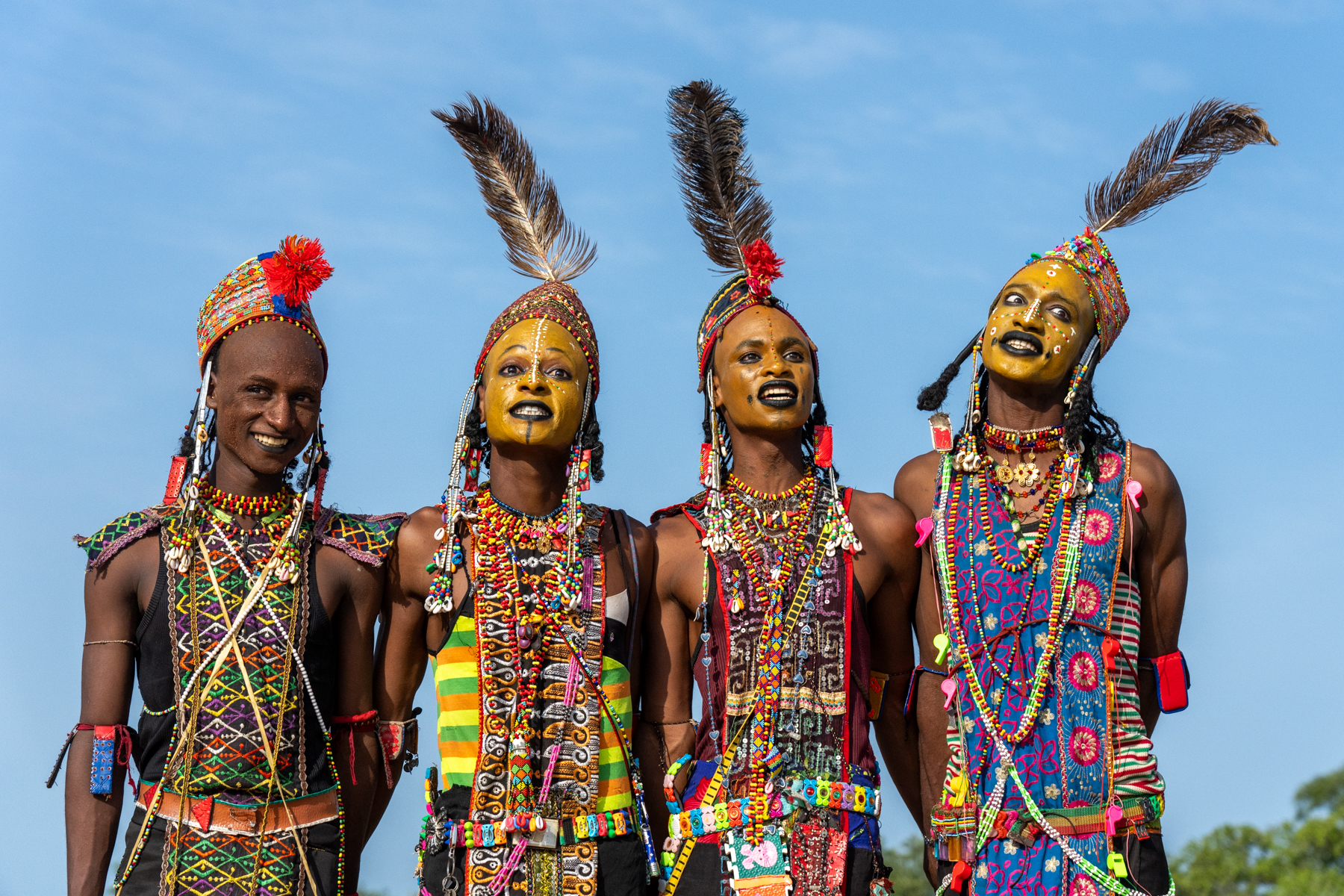
Young Wodaabe men singing at the Gerewol Festival. The only way to describe them is beautiful (image by Inger Vandyke)

A mirror view of a young Wodaabe man (image by Inger Vandyke)

Toubou girls riding their donkeys through the Ennedi (image by Inger Vandyke)

A Wodaabe boy sits atop his deconstructed home on a cow while he rides with 'migrating' Wodaabe families (image by Inger Vandyke)

Occasionally older Wodaabe men join in the dance of the younger guys at the Gerewol (image by Inger Vandyke)

Portrait of a shy young Wodaabe boy (image by Inger Vandyke)

On our 'sandbox safari' in the Ennedi we searched for scorpions with a UV light (image by Inger Vandyke)

Our Chadian driver in one of the beautiful arches of the Ennedi at La Grande Vache (image by Inger Vandyke)

Street scene in the desert outpost of Kalait, the gateway to the Ennedi in Chad (image by Inger Vandyke)

Detail of the horse rider rock art at Turkeï (image by Inger Vandyke)

Wodaabe nomad women on the move with their cows (image by Inger Vandyke)

The spectacular landscapes of the Ennedi Mountains (image by Inger Vandyke)

Wodaabe children are introduced to the spectacle of the Gerewol at a very young age (image by Inger Vandyke)

Toubou girls fetch water from Bachekele Oasis during an Araï, or dust storm (image by Inger Vandyke)

The smiling face of a Wodaabe gent attending the Gerewol festival (image by Inger Vandyke)

Some young Wodaabe men are so stunning they almost look like Queen Nefertiti of Egypt (image by Inger Vandyke)

Refining the art of facial expressions for the Gerewol (image by Inger Vandyke)

Shuwa Arabe people coming into N'Djamena on donkeys to sell firewood at a market (image by Inger Vandyke)
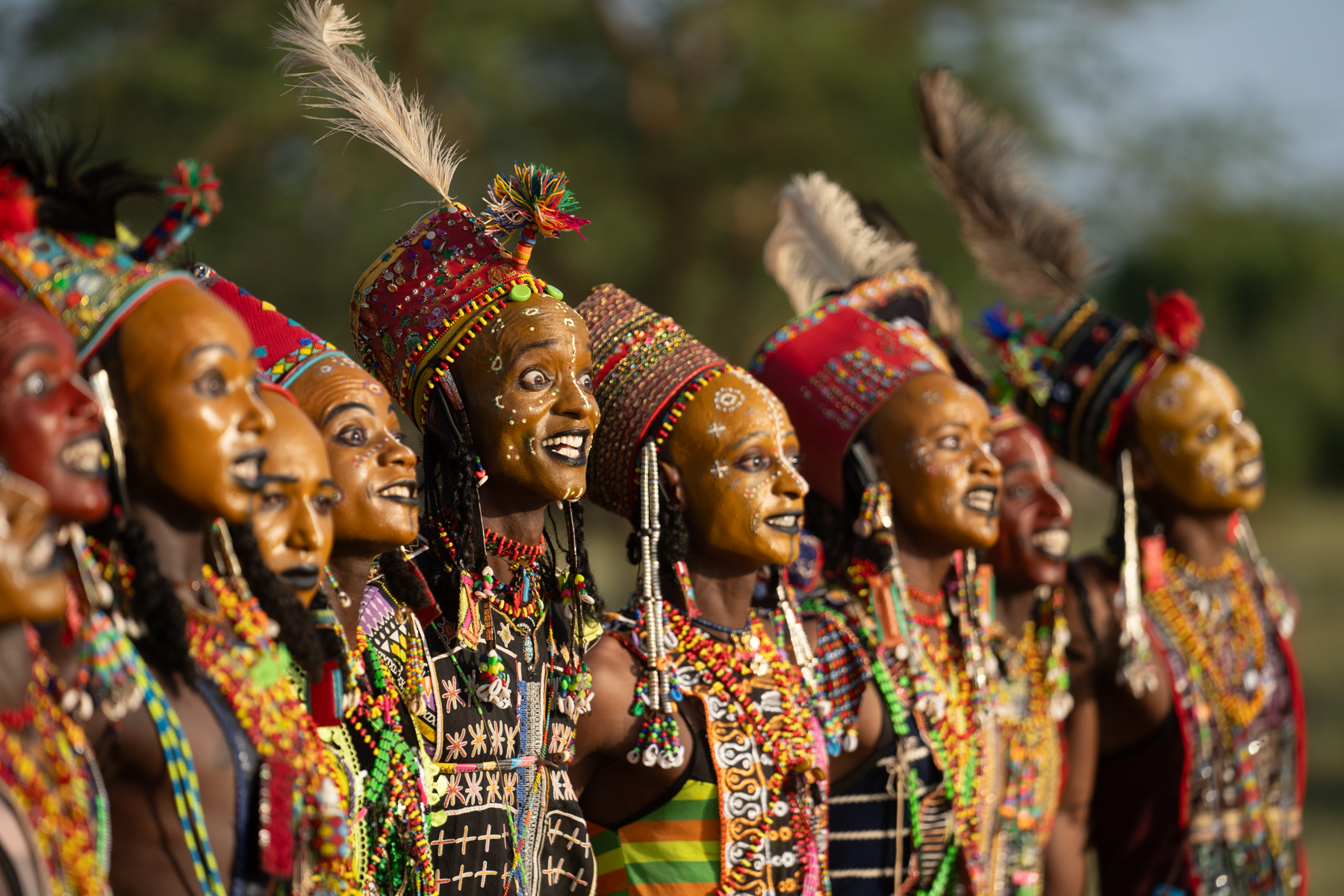
Strong facial expressions are seen as a highly attractive feature of Wodaabe men (image by Inger Vandyke)

African people don't travel, they move. On the road in remote Chad (image by Inger Vandyke)

Portrait of a Toubou girl and her baby sister (image by Inger Vandyke)

A trio of Wodaabe boys walk towards the dance arena of the Gerewol Festival (image by Inger Vandyke)

At dusk a beautiful Wodaabe girl joins the throngs of young women there to assess the attractiveness of young Wodaabe men (image by Inger Vandyke)

A beautiful Wodaabe girl with her facial tattoos and scarification (image by Inger Vandyke)

Shooting through the group of dancers to a solo Wodaabe young man taking a break in the Gerewol (image by Inger Vandyke)
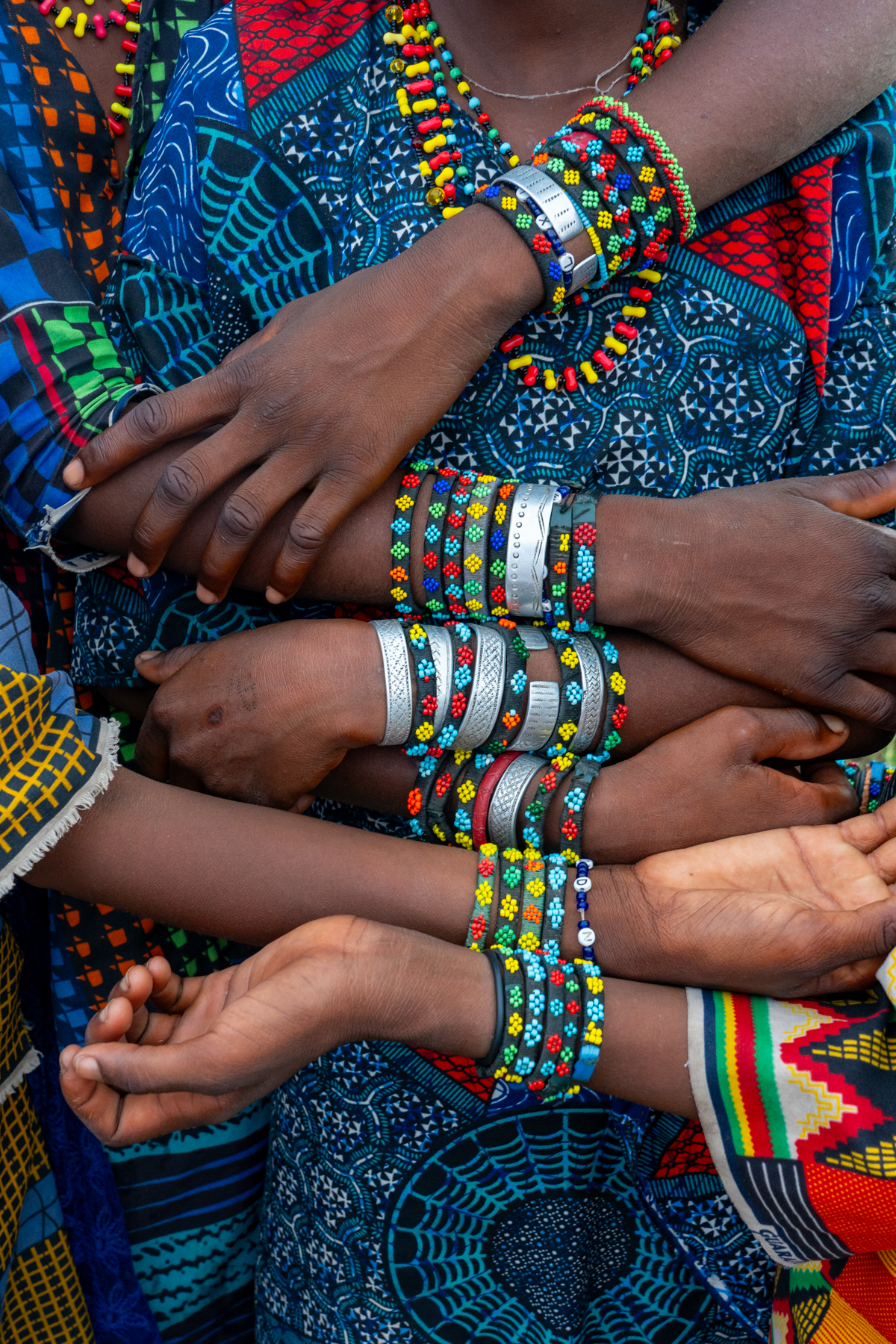
Beautiful beaded and aluminium bracelets worn by Wodaabe girls at the Gerewol (image by Inger Vandyke)

A Kotoko man demonstrating how men fish on the Chari river (image by Inger Vandyke)

Toubou boys in Bachekele oasis (image by Inger Vandyke)

Doum palms adorn the floor of Bachekele oasis in the Ennedi (image by Inger Vandyke)

A Toubou elder in the doorway of a traditional Toubou home in the Ennedi (image by Inger Vandyke)

Our Chadian guide inside the rock cave of Mandaguilé (image by Inger Vandyke)
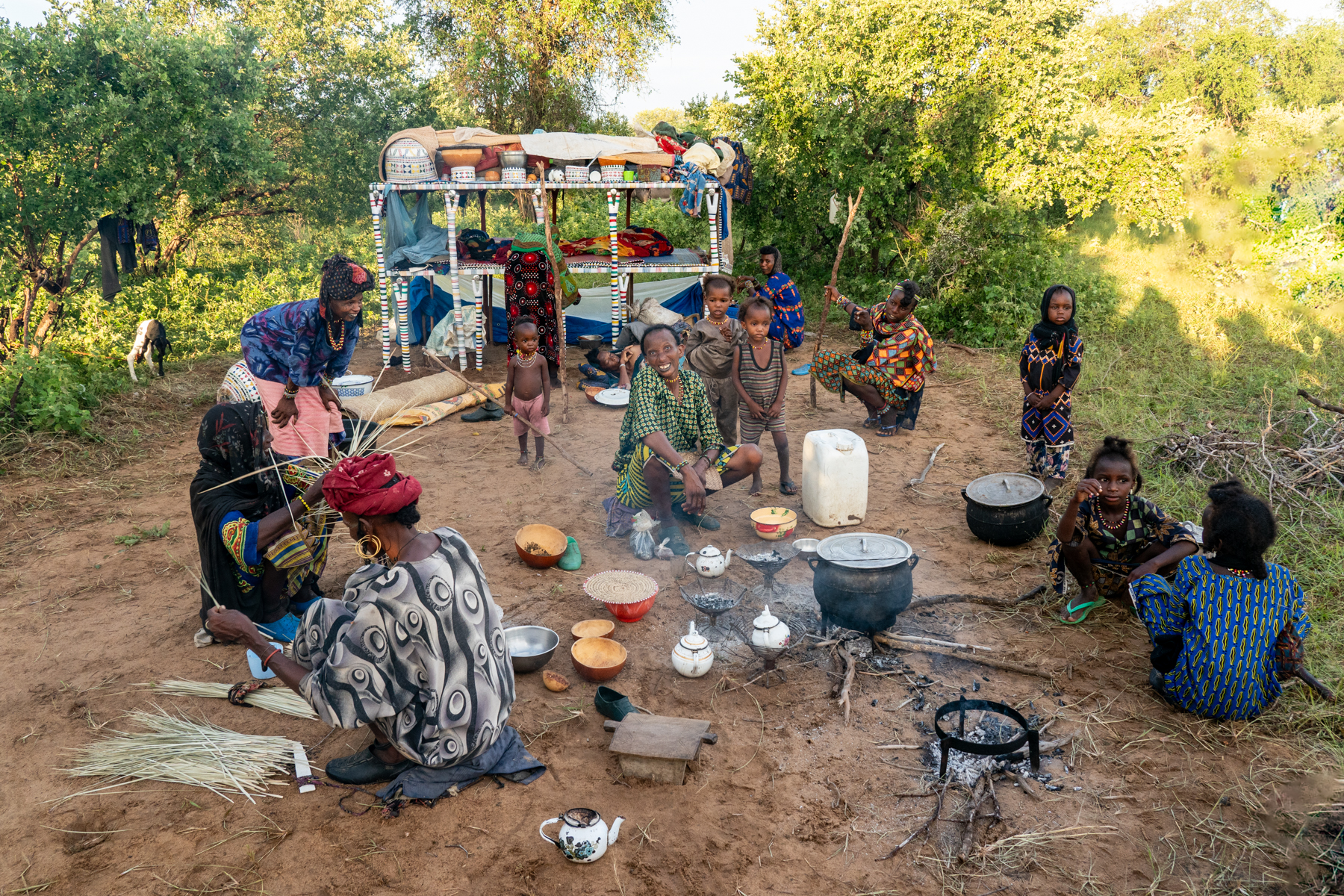
A Wodaabe family preparing dinner at their Wuro, or nomadic home (image by Inger Vandyke)

A solo tree in the desert near Ouadi Rimé, northern Chad (image by Inger Vandyke)

The terminus of the magnificent Guelta D'Archei oasis in the Ennedi of Chad (image by Inger Vandyke)

Beautiful Bachekele Oasis (image by Inger Vandyke)
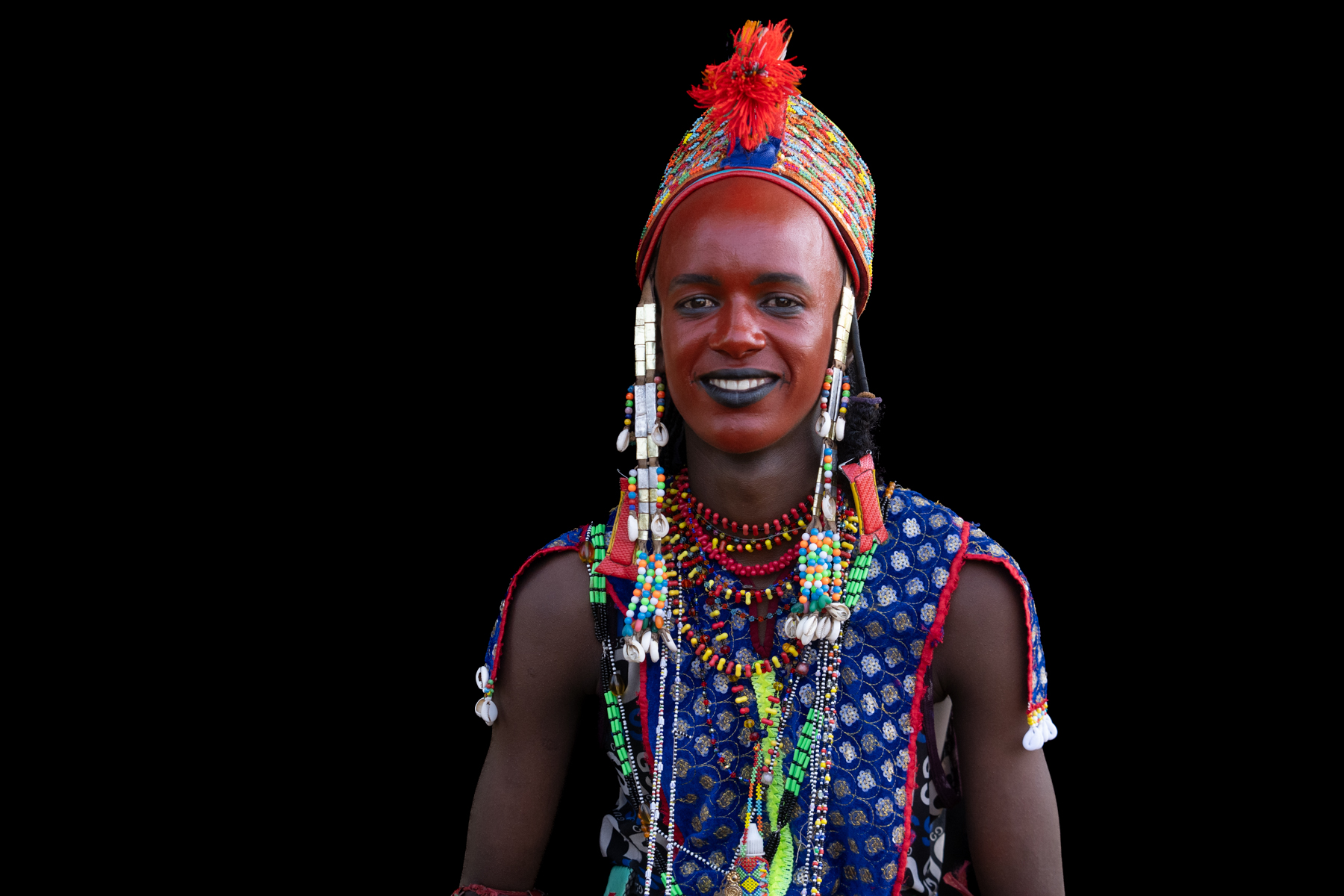
Smiling Wodaabe young man at the Gerewol (image by Inger Vandyke)
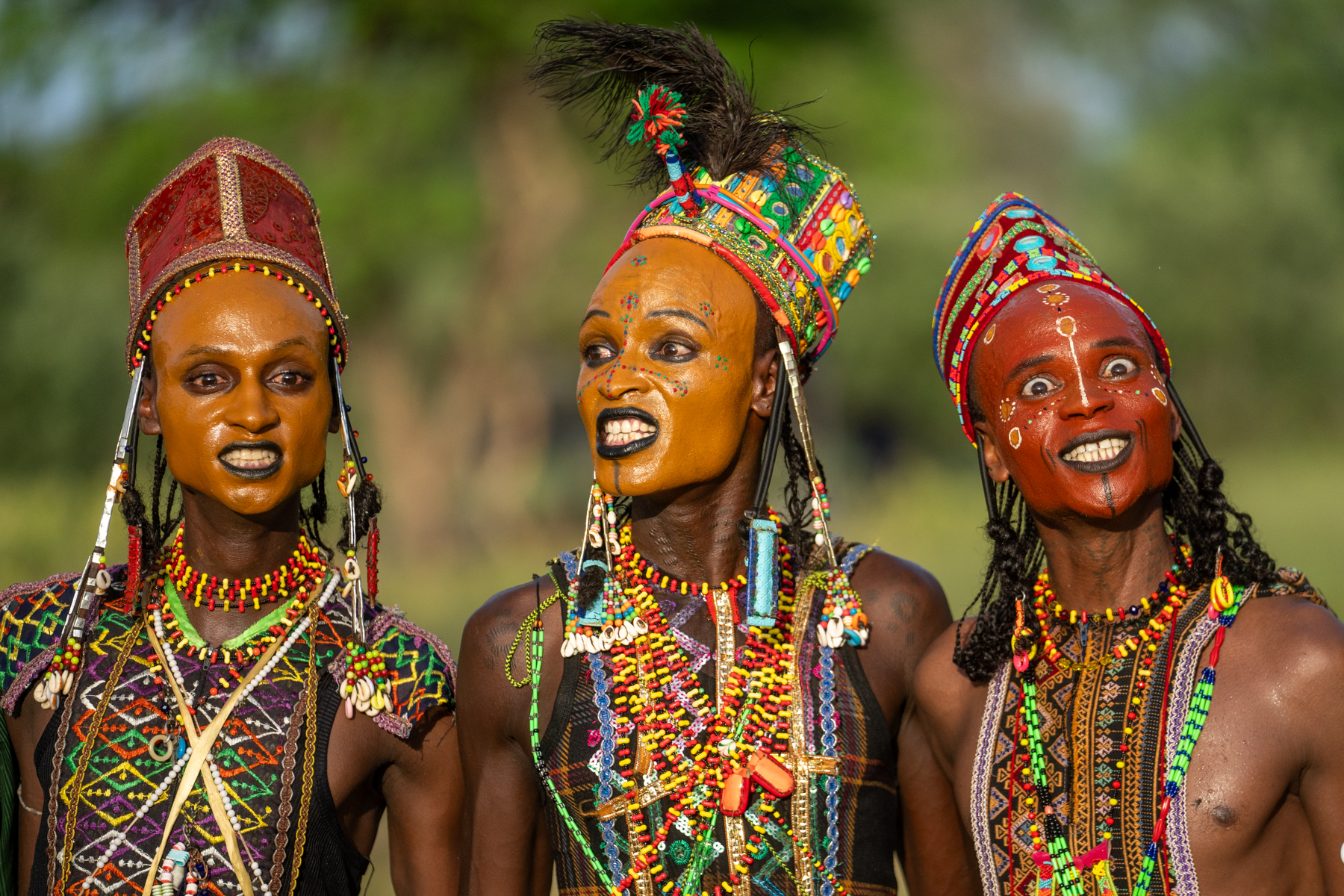
The incredible Gerewol Ceremony (image by Inger Vandyke)
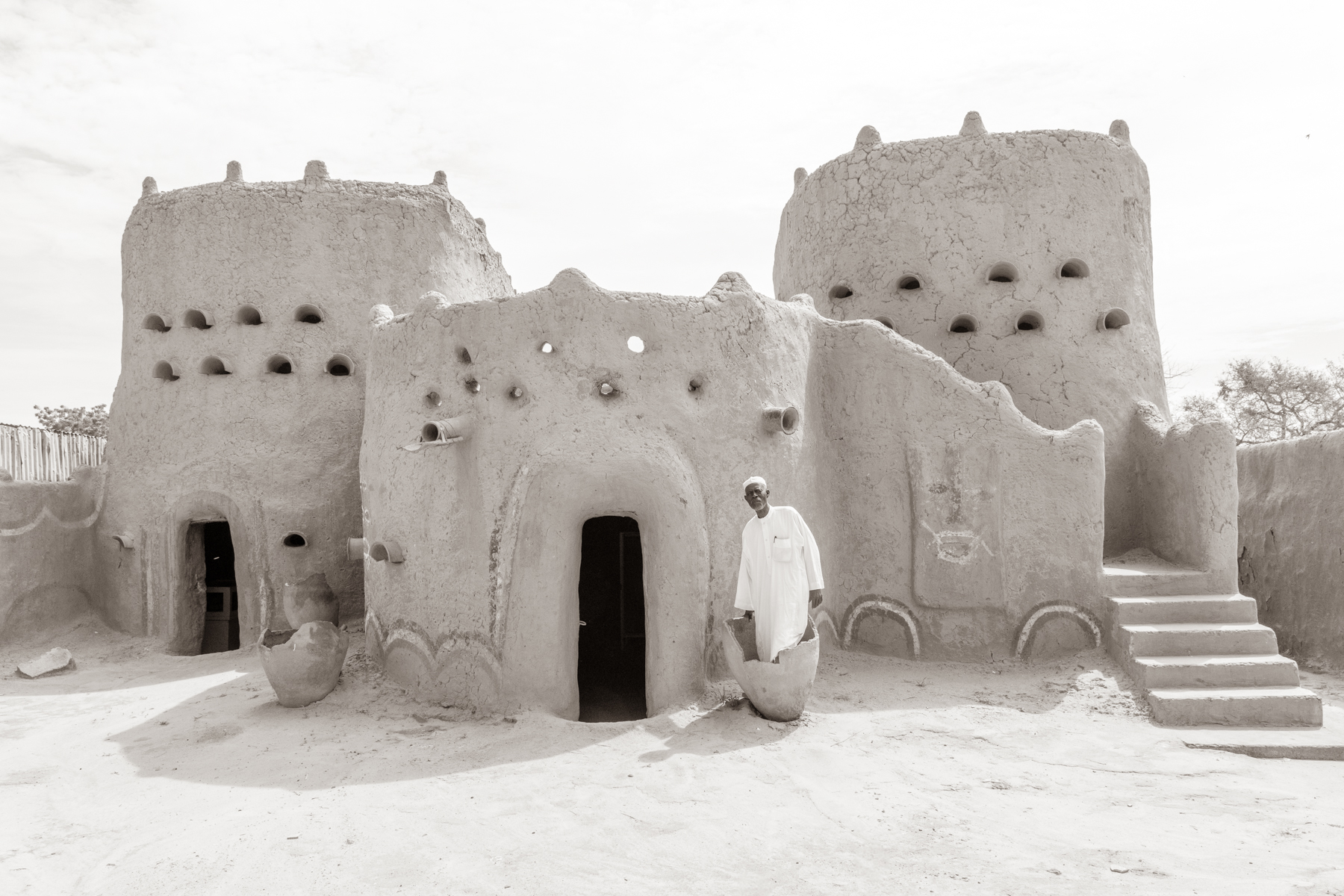
The ancient palace of Gaoui is the oldest building in Chad (image by Inger Vandyke)

Young Wodaabe men gather in the shade before they celebrate the Gerewol Festival (image by Inger Vandyke)

Gerewol grin (image by Inger Vandyke)

The sculpted rock arch of Bachekele (image by Inger Vandyke)

The Gerewol in Sepia (image by Inger Vandyke)

Our Chadian team at the rock art site of Turkeï in the Ennedi (image by Inger Vandyke)

Young Wodaabe girls also get into the spirit of the Gerewol and pull faces (image by Inger Vandyke)

Wodaabe men celebrate the Gerewol well into the night (image by Inger Vandyke)

Wodaabe are a sub-clan of the larger Fulani group of people. This handmade hat is typically worn by Fulani men (image by Inger Vandyke)
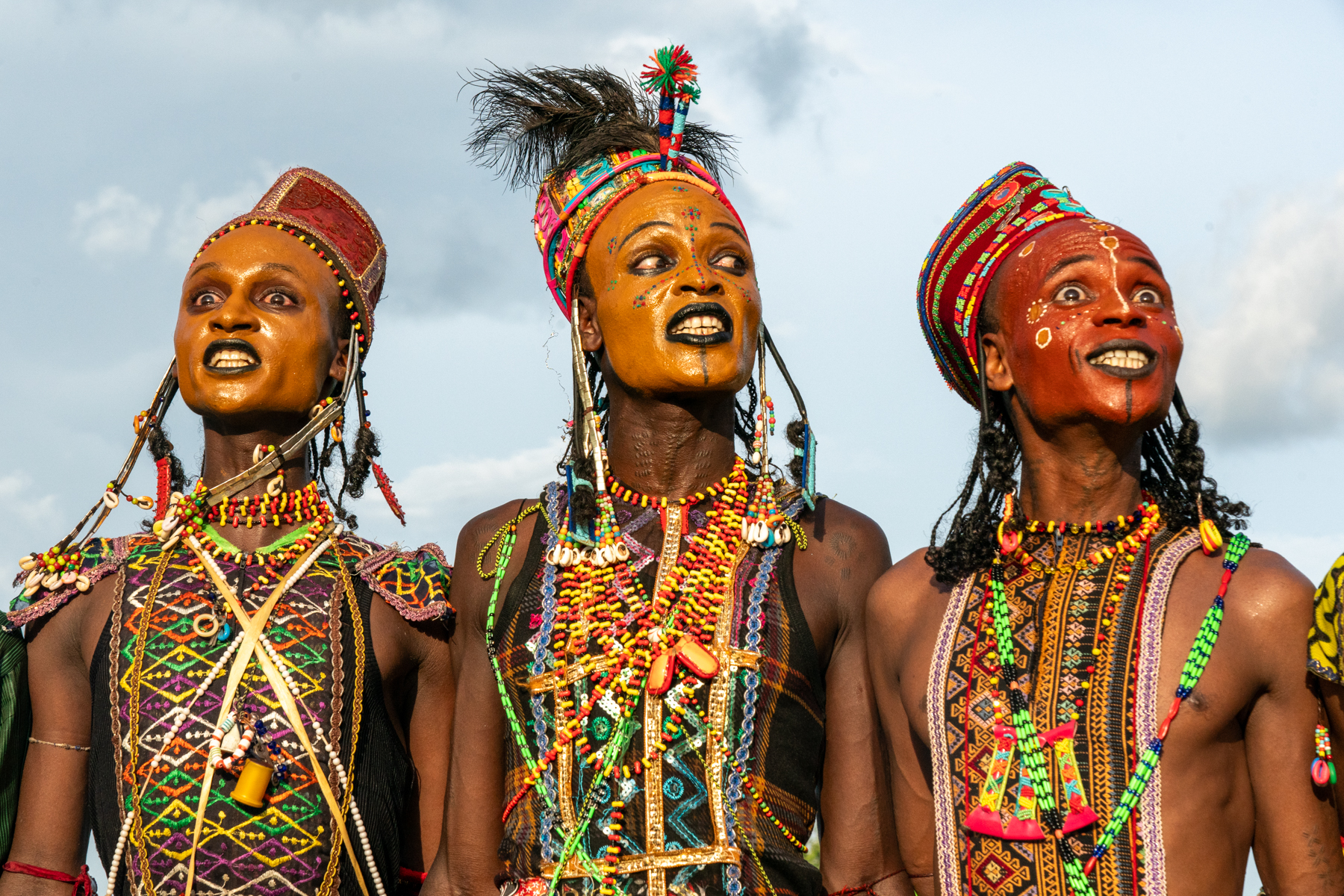
A trio of young Wodaabe men performing at the Gerewol (image by Inger Vandyke)

Smile practice for the Gerewol (image by Inger Vandyke)

A Toubou man herding his camels at Bachekele oasis during an Araï, or dust storm (image by Inger Vandyke)
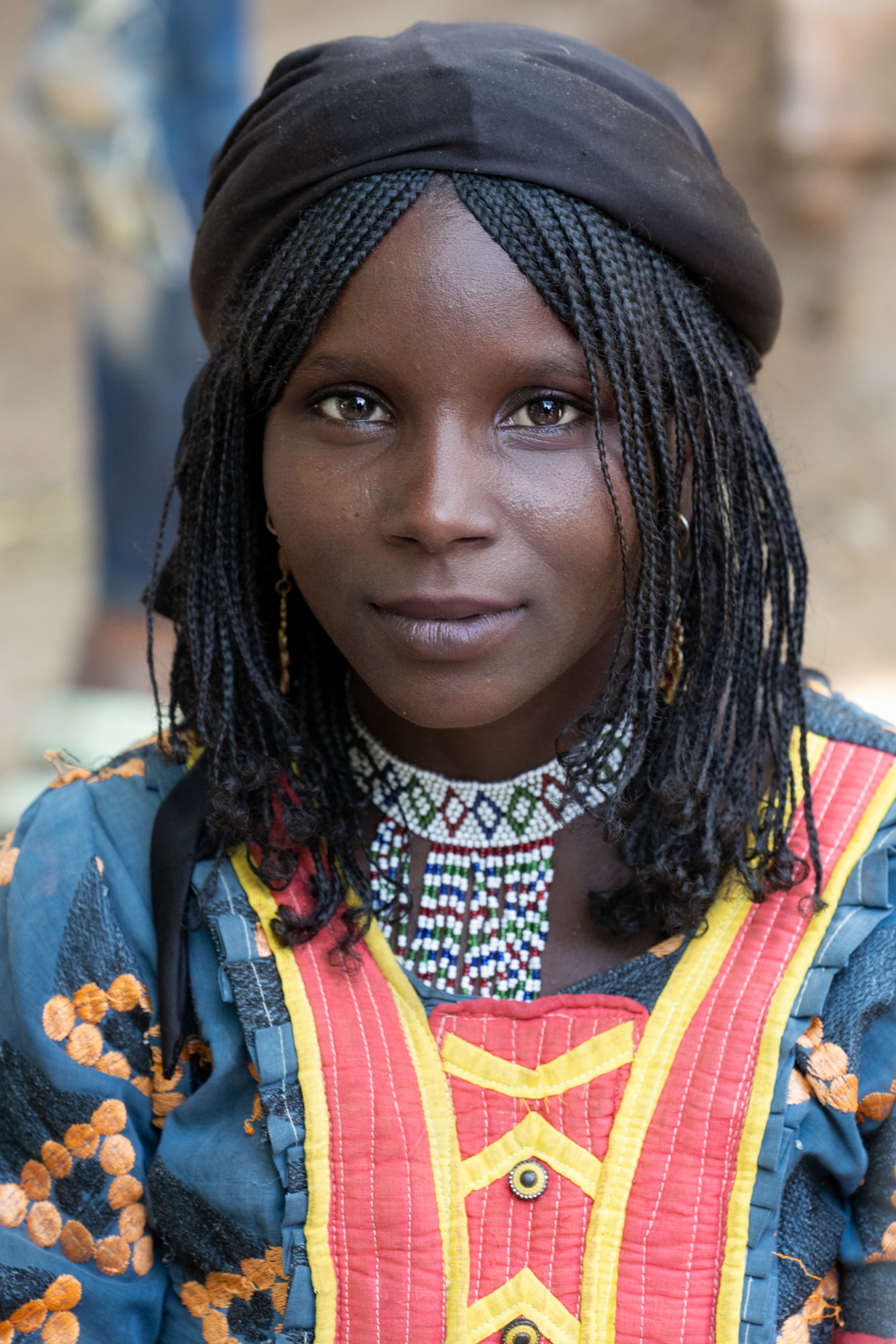
A Fulani lady selling goat's milk at Karnak in remote Chad (image by Inger Vandyke)

The stunning oasis of Guelta D'Archei (image by Inger Vandyke)

Toubou children outside their home in an Araï (dust storm) at Bachekele (image by Inger Vandyke)

Young Wodaabe men help each other to prepare for the Gerewol (image by Inger Vandyke)

Gerewol dancers (image by Inger Vandyke)

A stunning Wodaabe young man in blue (image by Inger Vandyke)

A Toubou shepherd boy rides his camel to haul water out of a very deep well in remote Chad (image by Inger Vandyke)

A Toubou cameleer bathes his camel in the spring-fed stream of Bachekele oasis in the Ennedi (image by Inger Vandyke)

A group of young Wodaabe men singing at the Gerewol festival (image by Inger Vandyke)

Detail of the beautiful ceremony tunics worn by young Wodaabe men at the Gerewol (image by Inger Vandyke)

A Toubou shepherd girl with her livestock at a well in remote Chad (image by Inger Vandyke)

Applying makeup is also a good opportunity to try out new facial expressions to prepare for the Gerewol (image by Inger Vandyke)
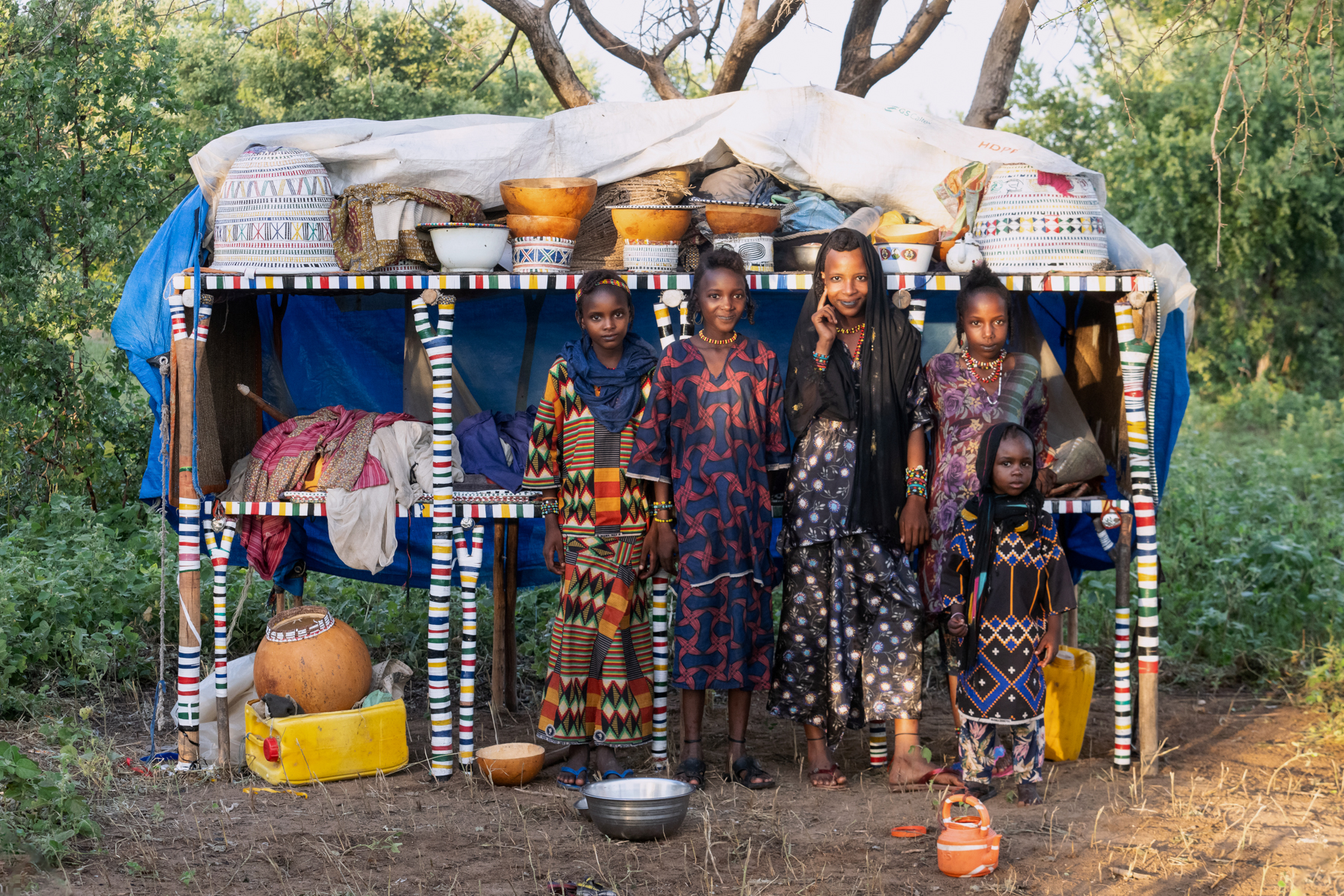
Young Wodaabe girls outside their Wuro (family home) in remote southern Chad (image by Inger Vandyke)

A Toubou shepherd herds his goats into Guelta D'Archei oasis to drink (image by Inger Vandyke)

The landscape photography opportunities of the Ennedi are endless (image by Inger Vandyke)

A Wodaabe elder claps to guide the young men performing at the Gerewol (image by Inger Vandyke)

Bachekele oasis by drone (image by Inger Vandyke)

Excited young Wodaabe girls leave their cattle behind to come and greet us (image by Inger Vandyke)

Portrait of a beautiful Fulani girl in Karnak, remote Chad (image by Inger Vandyke)

Drone's eye view of the arch of Aloba, the tallest rock arch in the world. At the base through the arch is our expedition vehicles (image by Inger Vandyke)
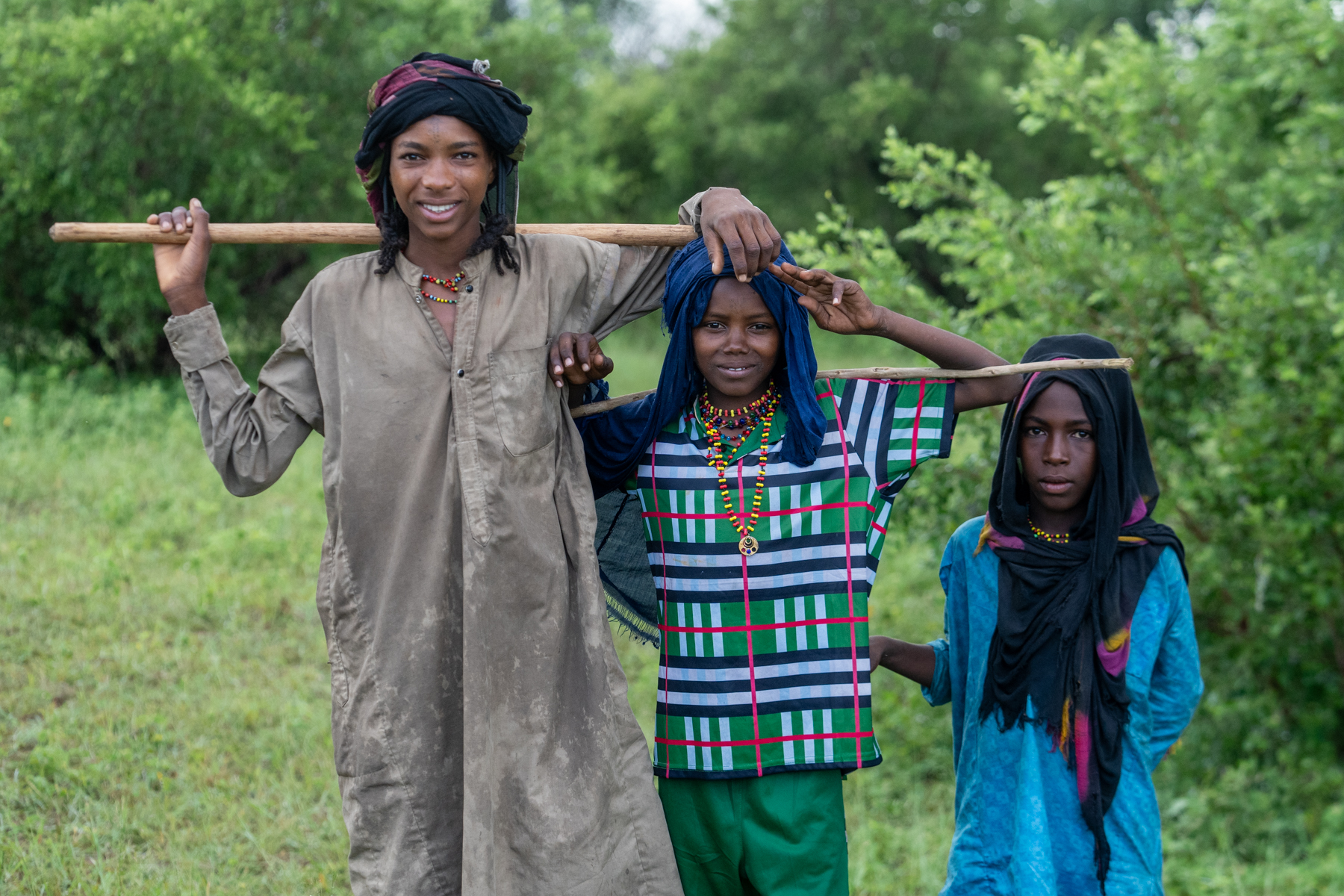
Young Wodaabe boys gather to watch young Wodaabe men prepare for the Gerewol, a time of much excitement for everyone (image by Inger Vandyke)
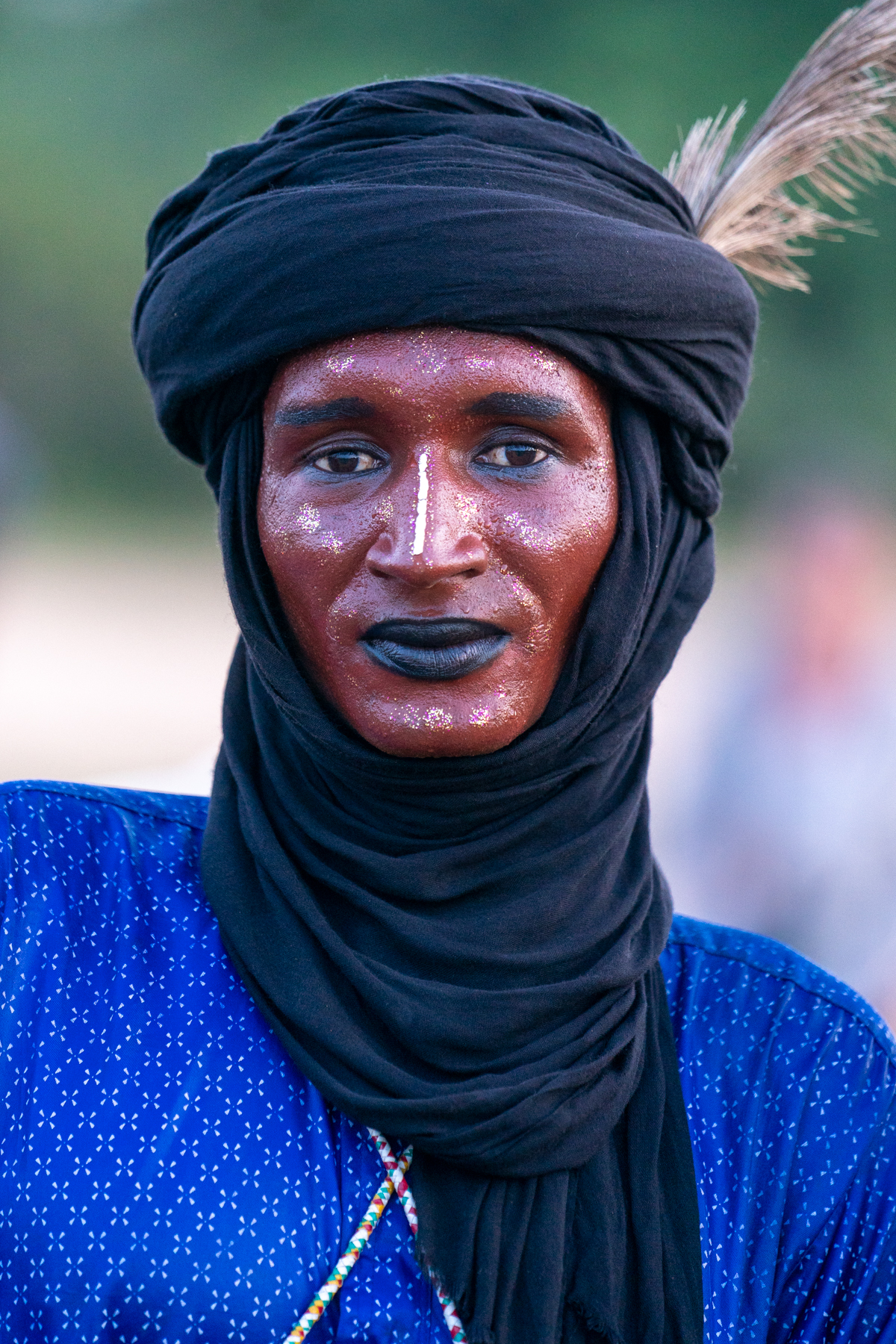
The Gerewol Festival attracts Wodaabe men from Chad and Nigeria in southern Chad. Portrait of a Nigerian Wodaabe who came to watch the dancing with us (image by Inger Vandyke)

Our guests walk into the base of the Guelta D'Archei oasis in the Ennedi (image by Inger Vandyke)

A small group of Wodaabe men dancing at the Gerewol (image by Inger Vandyke)

A young boy makes and mends clothes in the streets of Kalait (image by Inger Vandyke)

A smiling Toubou boy at Bachekele (image by Inger Vandyke)

Creating portraits while Wodaabe men dance at night is not impossible but it is difficult! (image by Inger Vandyke)

Street photography in Kalait, Chad (image by Inger Vandyke)

"Number 23" Saharan Ostrich. As one of only 25 birds on the Ennedi reintroduction program we were lucky to meet him (image by Inger Vandyke)

Elephant Arch with our guest walking the track at its base (image by Inger Vandyke)
Chad. This hidden gem of Africa lies deep in the continent’s heart with the centremost point lying in the town of Sarh, in southern Chad. Completely landlocked, Chad is not only one of the largest countries in Africa, it is the 20th largest country in the world.
Travelling from south to north in the country, if you cover enough ground, will see you starting in lush, humid woodlands, crossing the largest stretches of pristine grassland savannah in the Central African realm, before you finally end up in the Sahara.
I first visited Chad in 2017, accompanying my husband on the inaugural Birdquest expedition to the country searching for Niam Niam Parrot and other avian delights. We traversed almost every corner of Chad back then. The only places we missed, largely due to time constraints (six weeks wasn’t enough to cover the entire country by 4WD!), was the northernmost region of Tibetsti and Ounianga Lakes. We explored some extremely contentious parts of the country on that trip, including the controversial border regions near Central African Republic and Sudan and finally Lake Chad, which was very troubled when we first went. Despite all of the difficulties of travel in Chad in 2017 and the need for extreme care in some areas, I fell in love with the country. Even now when people ask me which is my favourite country in Africa, Chad is the first place I think of. It has a rugged wildness about it. The roads are rough, the travel conditions even rougher, there is hardly any internet, very little tourism and it is still possible to meet people in remote places who have never seen outsiders before. For travellers with a sense of adventure, its frontier feel is endlessly beguiling.
After we came home from Chad on our first trip I enjoyed my first hot shower in over five weeks and had a few nights in my bed instead of rough sleeping under trees and in the desert. The dust and tiredness may have washed away but the memories of our expedition lingered with me. I started to hatch a plan to return.
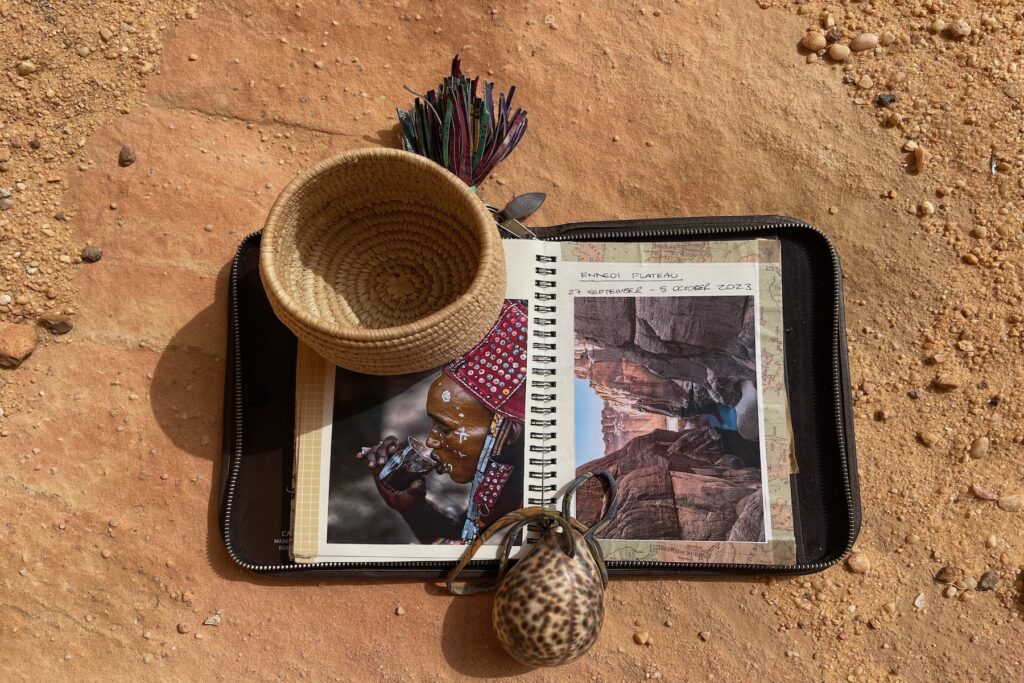
Notes from the field alongside a handmade Toubou basket and a shell for good luck (image by Inger Vandyke)
I began planning a photography expedition in two parts – the first to visit the incredible Gerewol ceremony performed annually by the Wodaabe (Mbororo) people in southern Chad and then a separate expedition to the north of the country which would explore the spectacular region of the Ennedi Plateau, one of the Sahara’s most intricately sculpted mountain landscapes. That expedition was planned for late 2020 and then Covid hit, effectively causing me to put it off until Chad was re-opened for tourism.
Fast forward to 2023, and I returned. This time, I was with a hardy group of photography travellers, some of whom have joined me on challenging expeditions elsewhere in Africa and the world. To be honest, I usually love all of my guests who join me on tours, but when I lead expeditions in countries like Chad, which are some of the most difficult places to lead anywhere on our planet, the guests who come with me – even if they start as relative strangers – often become some of my closest friends in the end. There is something about leading in these places that brings people together through a shared sense of adventure, a bonhomie that develops through the lack of creature comforts, the daily chatter of tent life and the group experience of witnessing things that so few other people on earth ever get to see.
SOUTHERN CHAD
We arrived in N’Djamena after our long-haul flights from Australia, Europe and the United States. It’s always wise to arrive a little early in the bustling capital of Chad. No one is able to travel freely throughout Chad without permits and while the process of arranging these has hastened with time, it’s still good to have a day or two to make sure everyone has their luggage, the permits are in place and the teams are ready to leave for regional Chad with everything you need to survive.
Gaoui
While our expert ground staff were doing last minute preparations, we took a day out to go and explore the satellite town of Gaoui. Heavy rains had hit N’Djamena in the days preceding our expedition so even reaching Gaoui, which lies in the city’s outer suburbs and next to a large refugee camp (home to a community of people from the Central African Republic who escaped the conflict in Bangui in 2013), involved driving through flooded streets, large potholes and negotiating our way through a traffic of local people riding donkeys or herding their livestock to markets in the city.
Gaoui is the home of Chad’s Kotoko people and also the country’s oldest building. It was first established as a commercial centre of the Sao Empire (6BC – 1600AD) but these days it is home to a community of ceramic artists whose simple mud houses radiate out from the narrow alleyways of the former Sao Palace, a stunning Sino-Sahelian adobe building that is maintained every year by a group of dedicated craftsmen committed to keeping it intact.
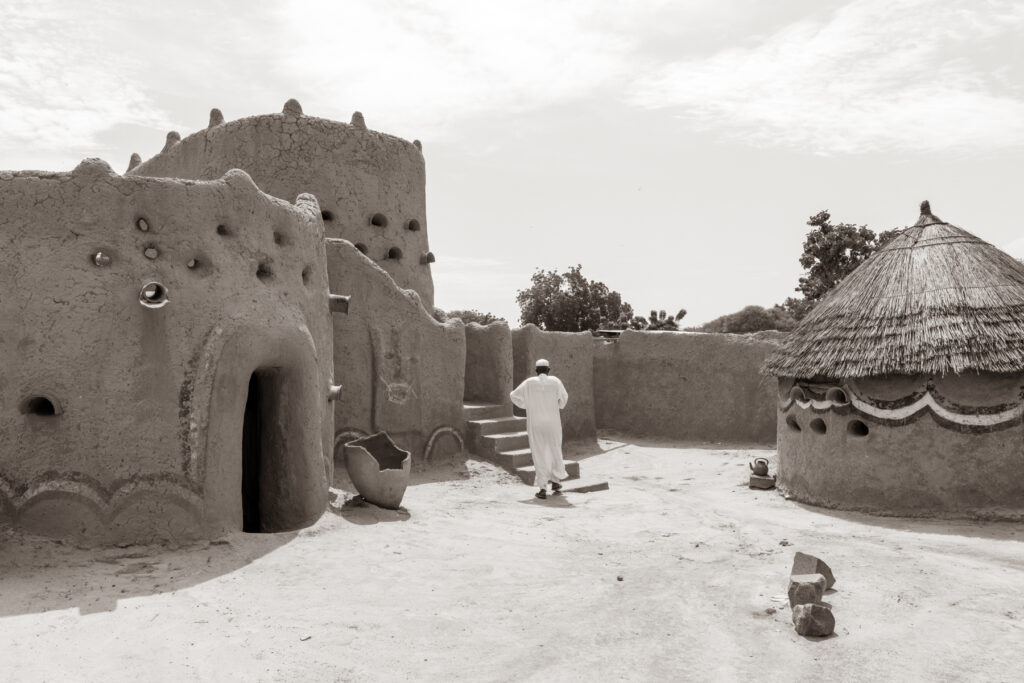
The ancient palace at Gaoui is the oldest building in Chad (image by Inger Vandyke)
We arrived in Gaoui and were instantly surrounded by crowds of excited Kotoko children who don’t often see foreign visitors. They quickly dispersed when we were greeted by our hosts and shown around the museum adjacent to the old palace. This was our first taste of painted Kotoko motifs and adobe architecture at Gaoui. Through our guides, we learned more about the Sao Empire and the Kotoko people who claim descendants from this ancient civilisation.
After touring the museum, we went off exploring the village on foot visiting ceramic artists in their tiny courtyards and just enjoying meeting people local to the area. We met an esteemed potter who had travelled to Turkey by invitation to show her work and who kindly gifted us one of her pieces each, leaving us all humbled and thankful to be shown her lovely work.
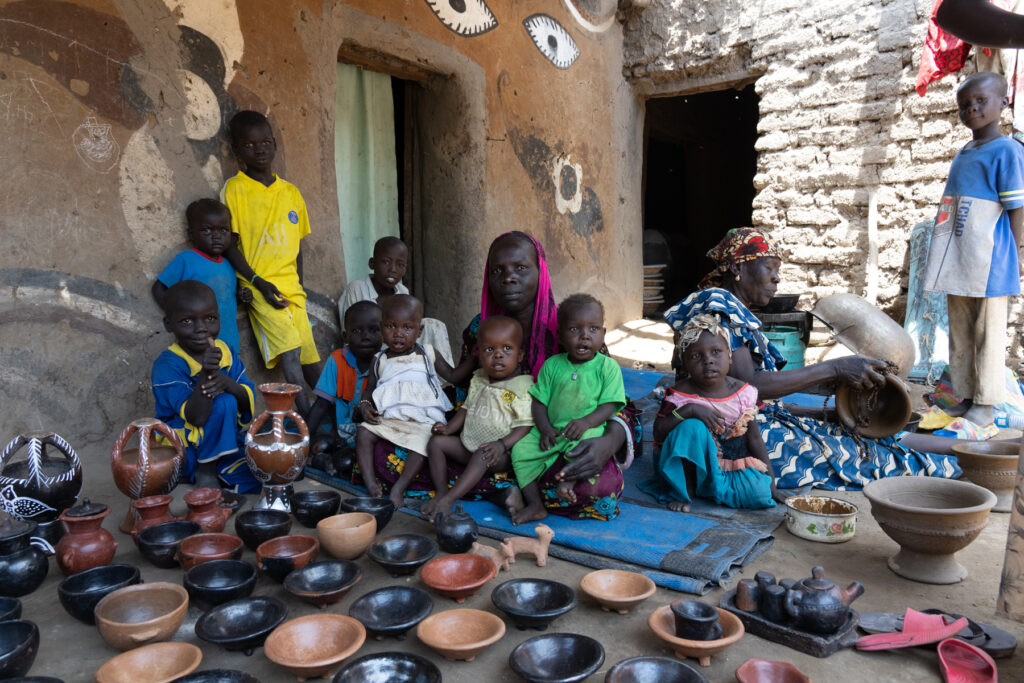
A family of Kotoko potters in Gaoui (image by Inger Vandyke)
Time was running out and we had to leave for the airport to collect our last expedition guest.
That evening we enjoyed a welcome dinner at our hotel where we excitedly prepared for the journey south to meet the Wodaabe people and attend the Gerewol Festival
The Gerewol Festival
We left N’Djamena the following morning to drive south towards Dourbali. The region where the Gerewol takes place is relatively simple to locate in expedition terms but finding the actual encampments of nomadic Wodaabe people requires good peole connections and a skilled knowledge of the area. After a little searching, we found some families belonging to the Sudosukai clan of Wodaabe and we set up camp near to where they had erected their Wuros, or temporary homes.
Our first nomadic Wuro was the home of two beautiful Wodaabe girls whose small children raced over to meet us as soon as we arrived. As soon as we had introduced ourselves I noticed storm clouds on the horizon. We were, after all, travelling at the end of the rainy season, at a time when the Wodaabe migrated to Chad to find grazing lands and salt licks for their livestock.
We were early arrivals for the Gerewol. Our host clan had arrived at the same spot only a day or two before us so nothing was prepared on the first day. The humidity was intense so the young men of the Wodaabe spent most of their afternoon in the shade, braiding their hair and preparing for the ceremony which would start that evening.
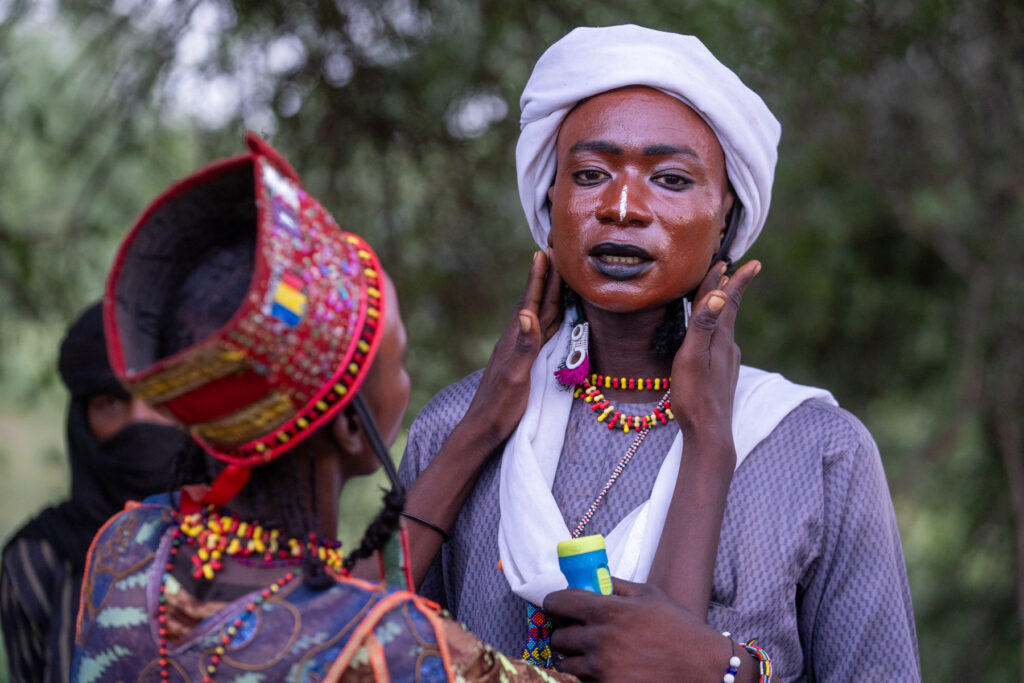
Preparing for the Gerewol (image by Inger Vandyke)
Attending these informal rehearsals of the Wodaabe allowed us to first hear how they sing, watch the boys practise their facial expressions and begin to decorate themselves for the main ceremony. We wandered occasionally between their camp and ours to just watch how beautiful they were.
After a brief thunderstorm which caused us all to take shelter and the Wodaabe people to cover their Wuros with large sheets of plastic, the sun came out again just in time for sunset.
Under beautiful skies, we went for a walk to meet other Wodaabe families camped out in the same area. Wandering between their homes and native woodland was wonderful. It seemed almost like each family had their bushland plot with their Wuro at its heart. We learned that Wodaabe people mostly sleep on the ground, while the Wuro was a place to store precious items and food and for small children to sleep.
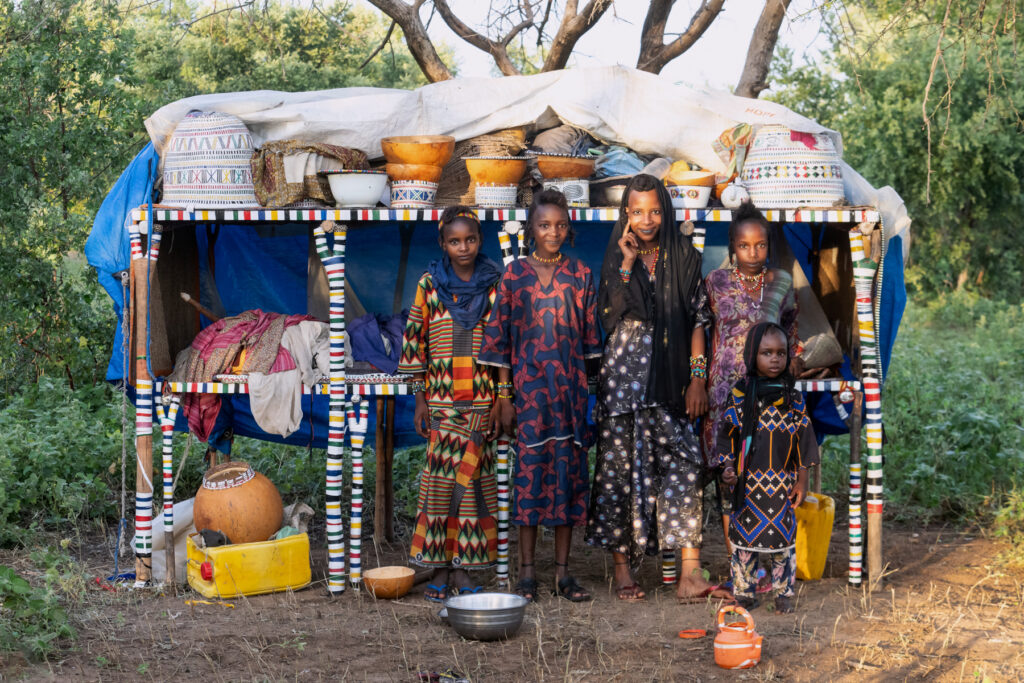
Young Wodaabe girls outside their Wuro (family home) in remote southern Chad (image by Inger Vandyke)
That night the young Wodaabe men performed their first dance to welcome us to their clan. After a dinner under a million stars, it was the most incredible introduction for us to the Gerewol.
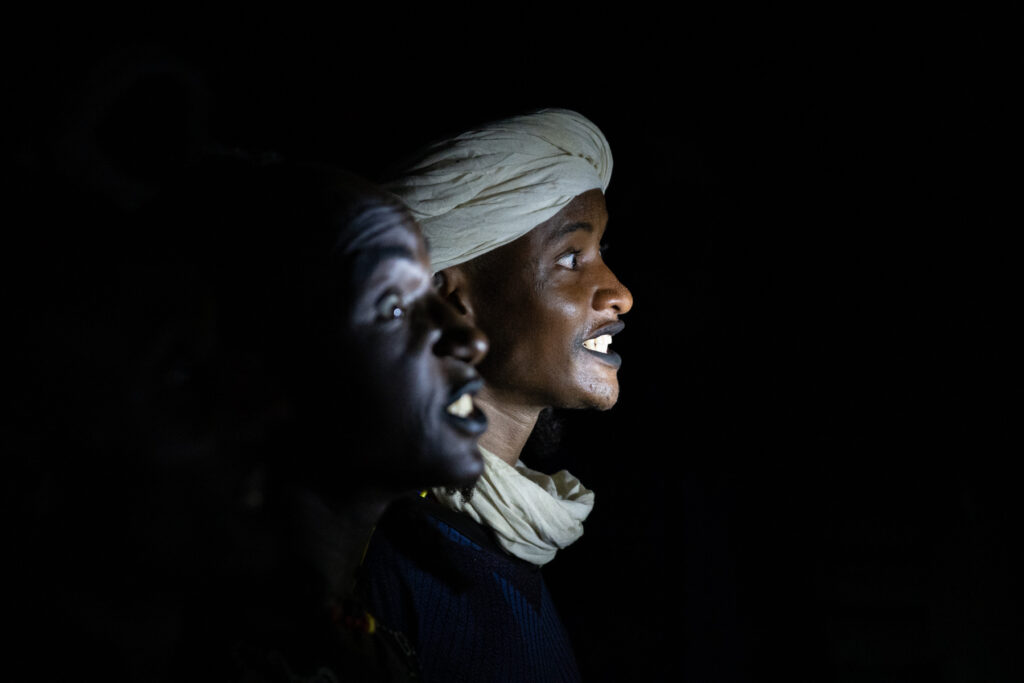
Our first night celebration of the Gerewol in southern Chad (image by Inger Vandyke)
The next day we woke up with our host families and we went off exploring the Wuros again, joining young Wodaabe children as they went out to herd their animals, engaged in milking and eating breakfast. We allowed them to dine in private while we did the same. The rest of the day was spent watching the young Wodaabe men paint their faces for the Gerewol and that afternoon we witnessed our first afternoon Gerewol which left us all speechless. Women and children joined in the singing and dancing, young boys practised their stick fighting and other Wodaabe people broke off from herding their cows back to camp to join us in watching this incredible spectacle, which continued well into the night.
For a few hours before sunrise, we were serenaded by young Wodaabe singing. It was magical to lie in bed listening to them singing in the darkness – the most remarkable wake-up call ever. At sunrise, we went to watch them and we were enthralled to see they had dressed up in their beautifully handmade ceremonial tunics. We stayed until the light became too harsh and the heat intensified forcing both dancers and photographer to seek shade in the bushes adjacent to our camps.
During the day we all took a long break in the shade and while we were there, quite a few of the Wodaabe children and youngsters came over to keep us company or simply say hello. We met some Wodaabe people who had travelled to Chad from Nigeria specifically for the Gerewol and it was wonderful to learn more about the Wodaabe through them as most could speak English.
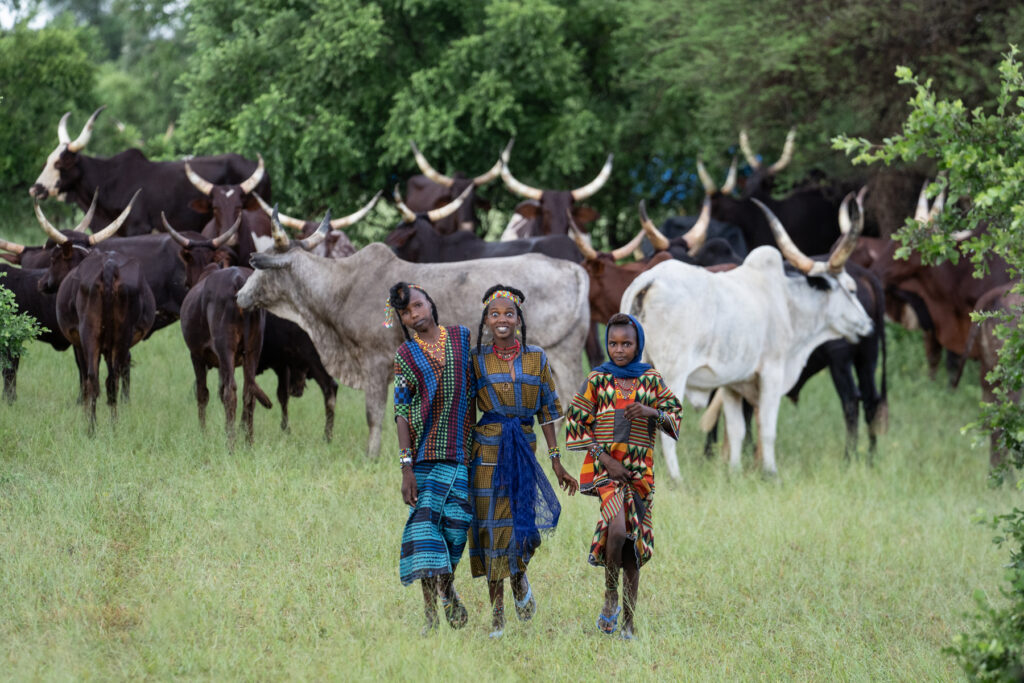
Excited young Wodaabe girls leave their cattle behind to come and greet us. Even young girls will copy the boys’ wide-eyed grins of the Gerewol! (image by Inger Vandyke)
Later that day we went off to the festival again and enjoyed another incredible afternoon with the young Wodaabe men singing and dancing for a marathon length of time.
We caught the last of the sun as it disappeared behind an inky storm sky and that night we camped in the most incredible thunderstorm! The lightning was so strong that at one point it was flashing all around us and it looked like a gigantic ‘lightning necklace’ in the sky! Of course that lightning brought with it a torrential downpour of rain and while we all thought we might brave it to get a a shower, we all took shelter instead. As an expedition leader you never know how resourceful you can get until you are suddenly face with an in-field challenge so I hopped out of my tent and, with the help of our team and our lovely leader, Yves, we rigged up a shelter using tarpaulins and two of our cars so we could actually eat the dinner made for us by the guys who had also fixed a similar type shelter using the trees to cover their kitchen.
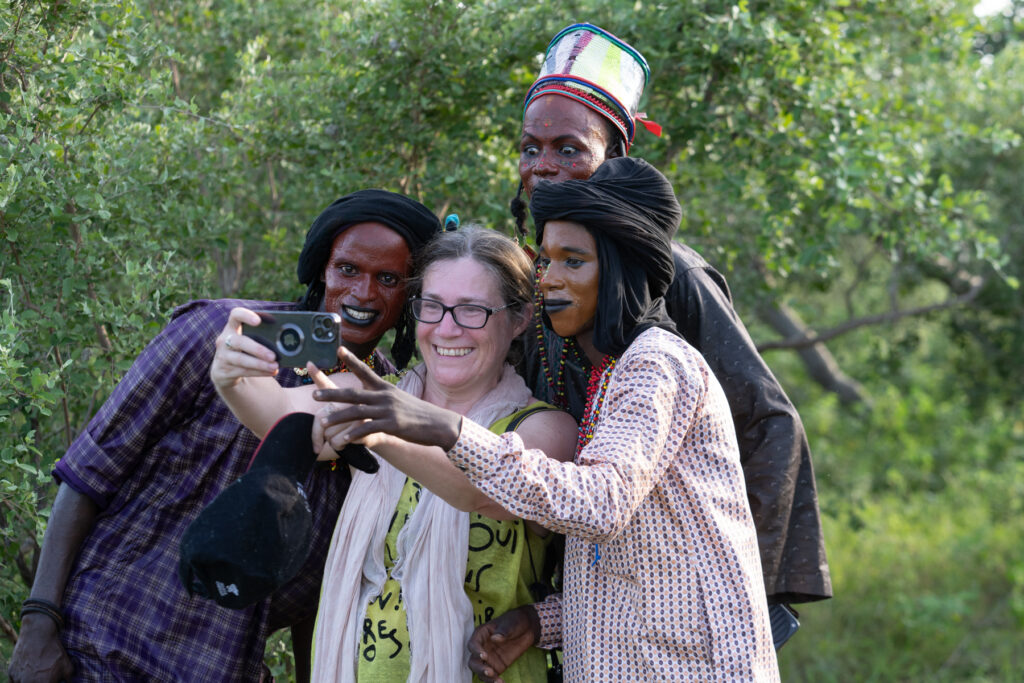
Wild Images guest Nat enjoying a group photo session with the young Wodaabe men (image by Inger Vandyke)
The next morning we packed up our camp. The families we’d lived alongside for the past few days had decided to move towards Massenya where other clans of Wodaabe were preparing for the Gerewol. While we waited for our local support vehicles to reach us, we gave some parting gifts to the people we had met during this first half of the southern section of the expedition.
When we finally got on the road, we all laughed when we realised that the support vehicle was also filled with some of our newfound friends grabbing a lift with us to our next stop of Massenya.
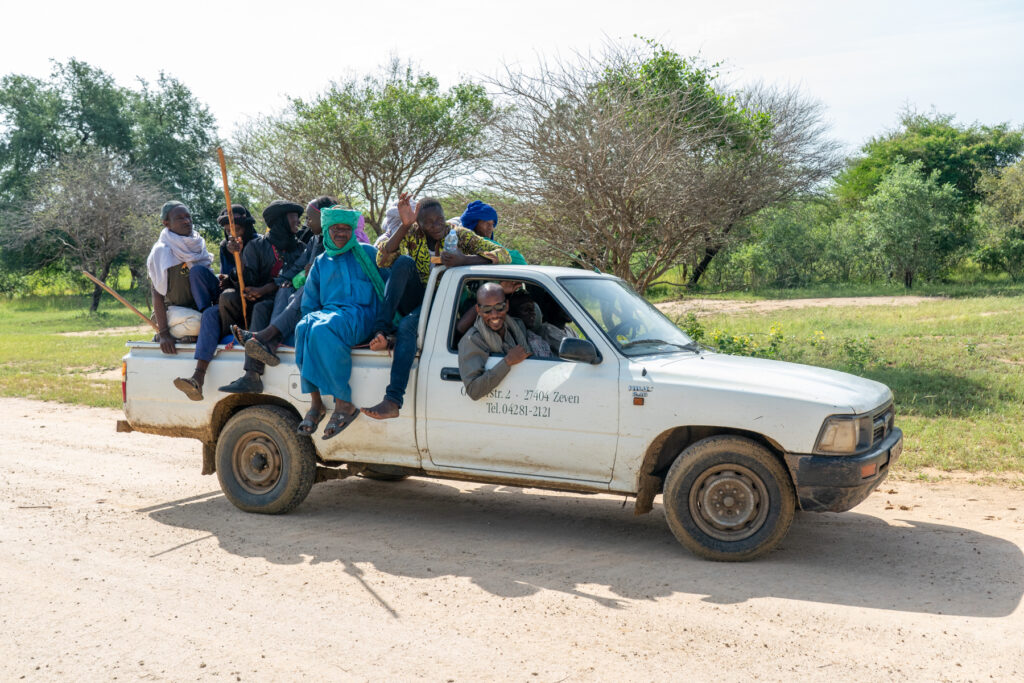
Our support truck in southern Chad wasn’t just used to transport our team and goods. We also took some Wodaabe guys with us when we moved camps! (image by Inger Vandyke)
During this drive, we were to witness one of the most extraordinary sights of our expedition. We chanced upon a migrating group of Wodaabe nomads who, among the several families we saw, must have been herding over a thousand head of cattle to a new grazing location. It was astonishing to see such a large group of people and animals on the move! They not only were very well organised but they were also fast! Seeing nomadic African people move to this degree is so rare that we jumped out and just walked with them. They kindly allowed us to walk for a while taking photos while they walked and it was fascinating to both try and keep up with them and notice the small things like small children and animals being carried, older kids taking all the goats and sheep while the men looked after the cows and women carried all of the homewares. There are so few truly nomadic people left in Africa. Seeing such a large group was an extraordinarily beautiful thing to witness and one that I think will stay with all of us forever.
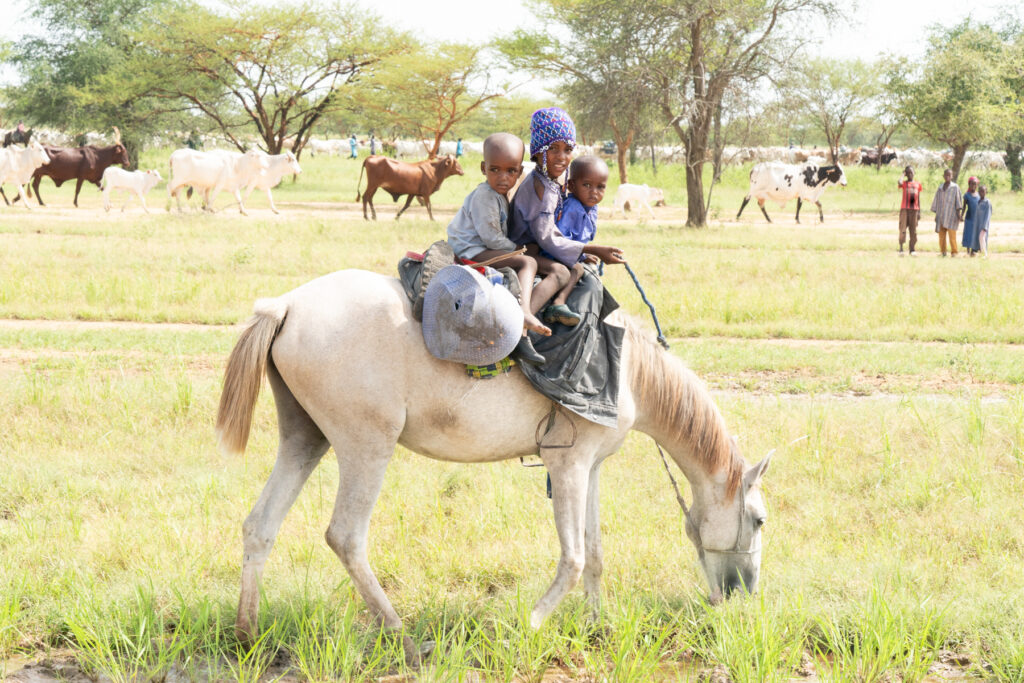
Nomadic Wodaabe children on the move with several families and over a thousand cattle! (image by Inger Vandyke)
Further down the road, we made a stop at Dourbali to make sure the cars had enough fuel and supplies to last us the next few days.
While we waited on the side of the road for our support cars we shared the company of a pretty, African Chameleon in a bush next to the road.
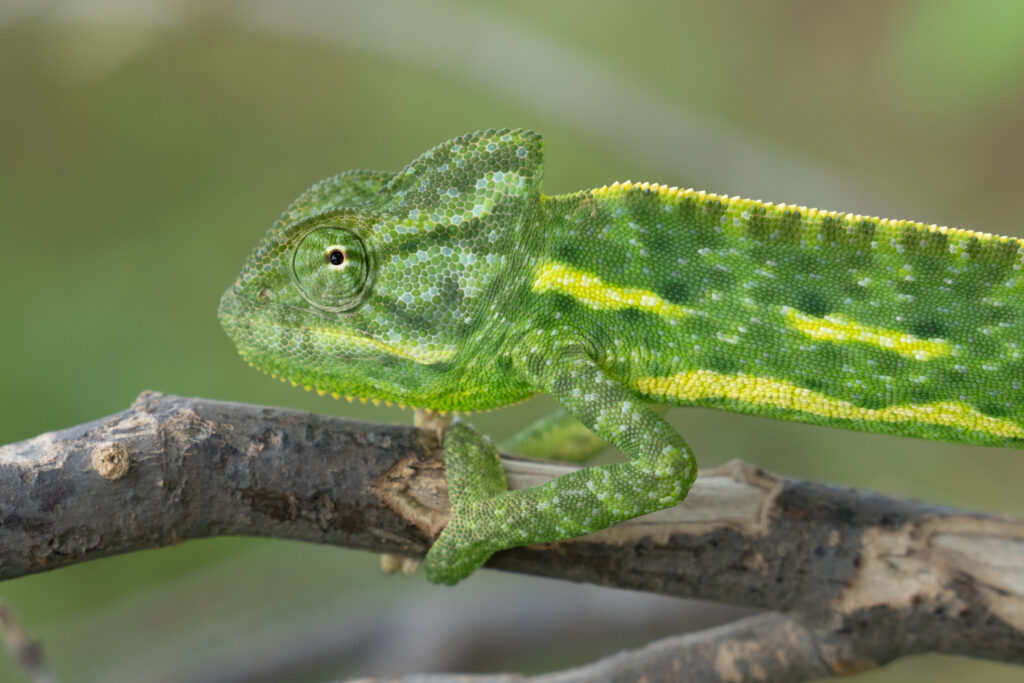
A young African Chameleon that we met on the side of the road in southern Chad (image by Inger Vandyke)
When our entire crew assembled we drove out to a tiny village where we met and photographed some beautiful Fulani women and girls at the local market while we waited for the local guide we needed to take us to our next camp.
The local guide was certainly needed as we ventured out into the bush on a labyrinth of unmarked tracks to try and find where our Wodaabe friends were camped out. The rains of the preceding night certainly made for an interesting journey with numerous large potholes filled with water. While we splashed our way through most of them we did have one that sunk our support vehicle and we had to tow it out. Our support crew were extremely skilled at handling the rough nature of drives in Chad so this incident was only a momentary hiccup in our journey. It took us less than twenty minutes to tow our bogged car out of the mire!
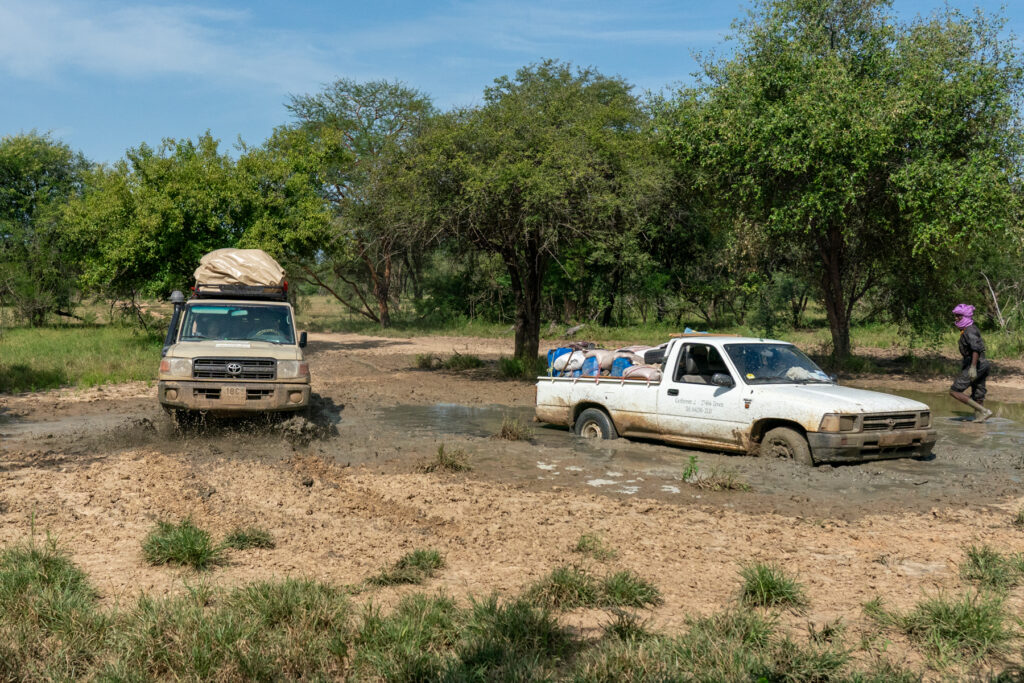
Our support team bogged in mud in southern Chad. We managed to get out really quickly! (image by Inger Vandyke)
We finally arrived at our camp around mid-afternoon, just in time to set up and enjoy a cold beer before a fantastic afternoon visiting our newfound Wodaabe friends and a night spent watching some of the local children practising for the Gerewol in the moonlight.
Our penultimate day of our journey with the Wodaabe saw us enjoying an incredible full day of the Gerewol Festival. It all started before sunrise when we heard young Wodaabe men singing in the darkness, even from our tents. There are many magical aspects of attending the Gerewol but being woken up by a serenade of young Wodaabe men singing traditional songs for the festival was a highlight.
We then spent the entire day attending numerous dances, alongside visiting Wodaabe and Arabe nomads, clan elders and numerous children. It was a spectacular day of celebration in a stunning open area with trees that allowed us to take breaks under the shade with the dancers and other attendants. The celebrations continued until sunset and for the last few hours of the day the light was simply incredible. It was incredibly hot and sweaty but enthralling. Some of us took turns to go and sit in the middle of a circle of dancers to take photos but the collective singing was almost deafening so we couldn’t linger long. It didn’t really matter in the end. The entire spectacle was overwhelmingly beautiful and it continued long into the night. The stamina of these young guys to continue singing and dancing for hours amazed all of us.
Starting at sunrise the following morning we visited the local Wodaabe boys getting ready for the dance. It was our last morning at the Gerewol and none of us wanted it to end. We joined in the celebrations right up until we left and we felt really sad to say goodbye!
Before we left, many hugs, thank yous and gifts were exchanged as we parted company with the Wodaabe clans who so kindly shared their world with us over the past week.
As we drove out we were surprised to see a small group of nomadic families on the move with their cows and donkeys so we stopped to walk with them for a while and take photos before driving out the same labyrinth of tracks to get back to ‘civilisation’.
On the same labyrinth of bush tracks we drove on a few days earlier we found a huge shady tree to sit under to have lunch, before driving to a local village where we checked our cars for fuel and take a small break before driving out of the woodlands. As the afternoon wore on we tried to find an encampment of nomads to camp alongside that night but we had no luck so we pitched camp near the roadside and next to some small agricultural plots that were being run by Arabe nomads who occasionally visited on their donkey carts. Even though we were close to the road, the donkey carts were the main traffic we met during our night of transit back to the city.
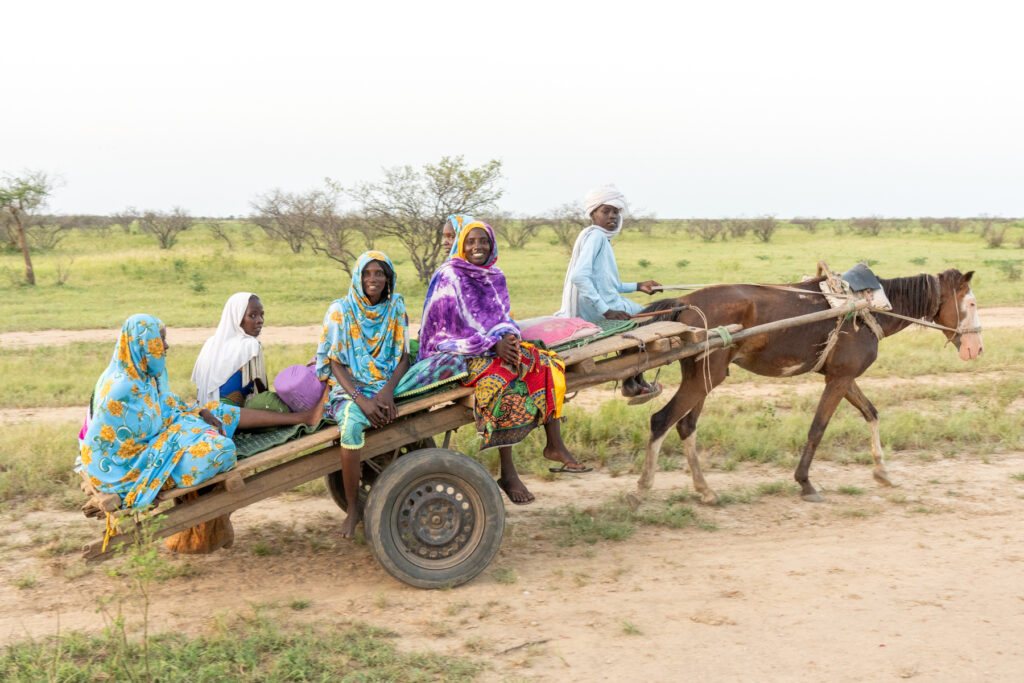
Shuwa Arabe family on the move past our camp in southern Chad (image by Inger Vandyke)
The next morning we packed up and, on our drive back to N’Djamena we were surprised to find all of our Wodaabe friends on the move with their stock, families and packed-up Wuros. Their Gerewol dancing was over and it was time for them to relocate. We all got out of the cars and walked with them for a while taking photos of this incredibly organised group. I will never forget us all calling to the people we met whom we knew on a first-name basis after spending a magical week camping alongside them. It made us all feel even sadder that we had to leave. Spending time with Africa’s true nomads is an increasingly rare opportunity so our final farewell with them was a true honour and I’m sure some of us just wanted to continue walking with them, even though we knew it was impossible.
We reluctantly went our separate ways from our friends and drove back to N’Djamena in time for lunch, a much-needed shower, some laundry, camera battery charging and a cold beer! The night in the city allowed us all to get in touch with the outside world and regroup before the second half of the expedition – to the northern part of Chad and the spectacular Ennedi Plateau.
NORTHERN CHAD
After our wonderful night of resting and recharging in N’Djamena, we collected another expedition member and started our long journey north to northern Chad.
At Moussoro we left the bitumen roads behind and from then on it was just us, nomadic Arabe people and the wind as we embarked on our three-day drive to reach the spectacular Ennedi Plateau.
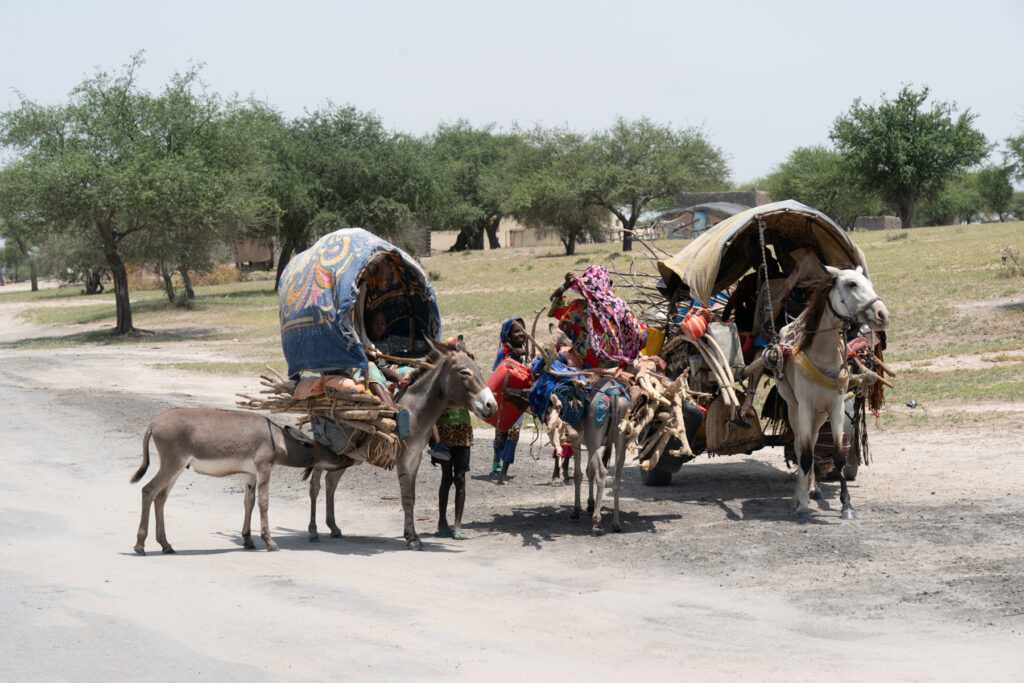
A family of Arabe nomads on the roads outside of Moussoro (image by Inger Vandyke)
With making only brief stops to photograph some of the local huts and a very shy group of Arabe nomads, we all noticed how the landscape began to change from the more verdant forests of the south into the more arid acacia woodlands of the north.
As the sun started to set we found a beautiful camp in a grove of acacias where we spent the night and watched Arabe nomads occasionally wander through on their camels.
It was during our second day on the road that we watched the acacia woodlands fade away into the incredible desert landscapes of northern Chad. We started with a long drive through an incredible stretch of grasslands, past numerous encampments of Kanem people until we eventually reached a really deep well that was being visited by a small group of nomadic Toubou people who were drawing water from it using long ropes, buckets and cows and donkeys to draw the water-filled buckets to the surface. We stopped for a while taking photos and meeting them before driving further to the north-east to reach an outpost called Wolouma with its abandoned school that was occupied by donkeys!
On the way there we were astonished to see large flocks of migrating Scissor-tailed Kites which was an incredibly unique avian highlight of our trip. They were on migration to countries like Senegal after the rains of the Sahel in Chad.
We stopped for lunch and water here while we waited for our support crew to catch us up. When they finally arrived we drove towards the northeast and stopped at Bathandjenna for lunch.
Ouadi Rimé
That afternoon we entered Ouadi Rimé, one of the largest conservation reserves in Chad. It was here that the nomads disappeared and we were truly in the wild. While we searched for some of the rarer mammals that had been introduced to Ouadi Rimé, sadly they weren’t easy to find in such a huge expanse. We did, however, count 71 Dorca’s Gazelles on our drive into the desert and around sunset we arrived at Ouadi Achim where we set up camp for the night on a treeless plain.
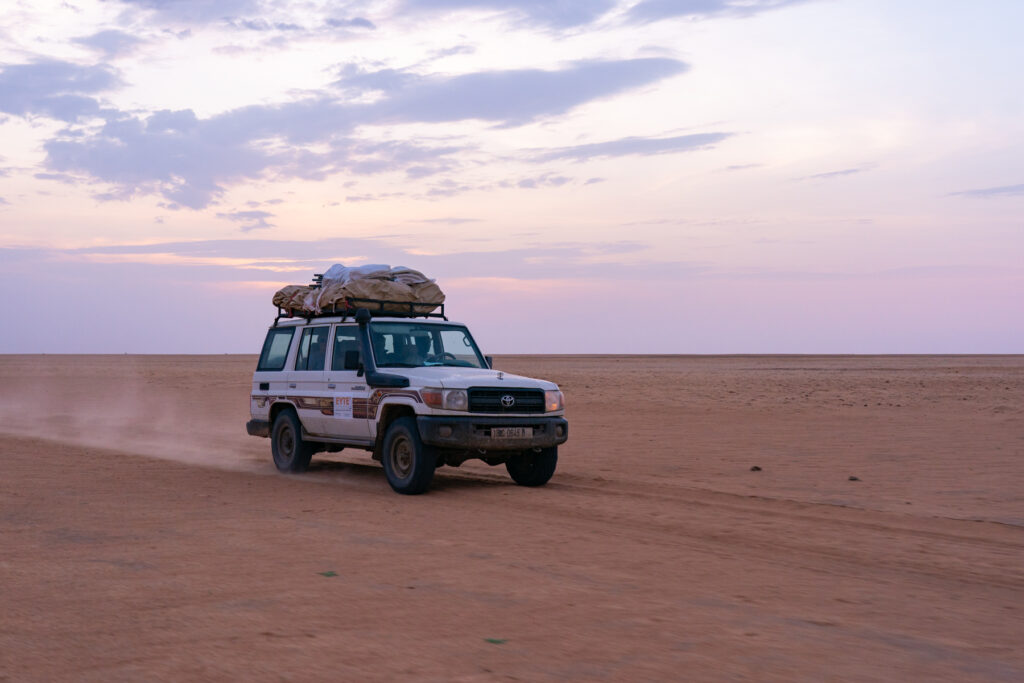
Our expedition vehicle racing across the desert in Ouadi Rimé at sunset (image by Inger Vandyke)
The next morning while we packed up camp we all enjoyed encounters with some of the lovely Saharan insects you can find in this part of Africa including wind scorpions (solifuges) and dung beetles. We also had a short visit from a wandering Lanner Falcon.
Our overnight camp was a short drive (by Chadian standards) from the frontier town of Kalait so after we packed up we followed the treeline of an ouadi to the north and around 15km in we met an amazing group of nomadic Toubou people on the move with their camels. We stopped to take photos of them as they seemed to be surrounded by flocks of birds which made for a really interesting photographic scene!
Eventually, we left them when we found a track that would allow us to cross the ouadi without getting bogged and after we crossed we spotted a Nubian Bustard wandering into the low-slung ouadi woodlands. We tried to photograph it but it was incredibly shy so we continued our journey towards Kalait.
Kalait
Just before we reached the town we drove through a remote military outpost complete with a cluster of rusting vehicles and tanks that were a remnant from the war between Chad and Libya that was fought between 1978 and 1987. It was still being used by the Chadian military so, sadly, it was impossible to stop and take photos.
As we neared Kalait I was amused to see that there were now motorised tuktuks driving around the dirt roads of the town. The ever-resourceful nomadic Toubou people of the area were even driving one out of the town that was stuffed with matting used to construct their homes!
We had to check in at security before we could do anything in the town. Afterwards we drove into a mechanic’s yard in the heart of the commercial centre of Kalait. While we had our vehicles checked, our tyres mended and the support team restocked the expedition with food and fuel, we decided we would go off on a walk with our local guide to check out the local markets and other small stores in this bustling frontier. It was a good way to meet some of the local people and take some street photos before we left once more for the desert.
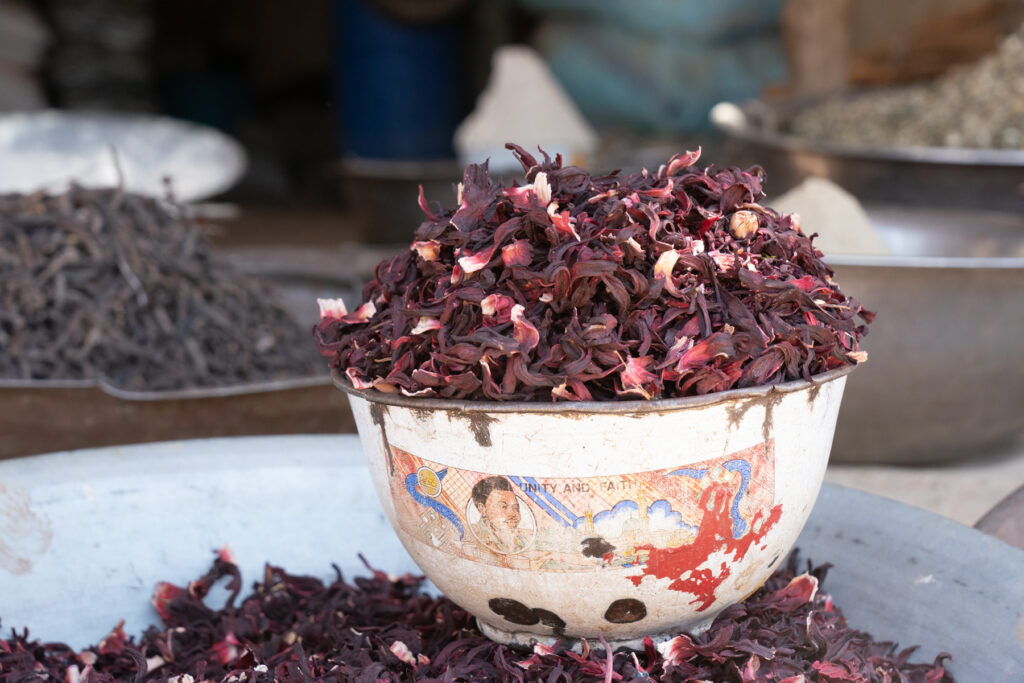
Dried hibiscus flowers for sale at the market in Kalait (image by Inger Vandyke)
The Ennedi Plateau
The vehicles were finally ready to leave so we packed up and drove north to the Ennedi, stopping in the shade of an ouadi for lunch before our final stretch of desert roads to reach this incredibly remote part of Africa.
We eventually saw the dramatic landscapes of the Ennedi unfolding on the horizon. They had been transformed by recent rains and the whole area was surprisingly green. We stopped at a small settlement of Toubou people where one of our drivers had family. Amusingly we also stopped when he found his camel he’d lost three years ago!
We continued north and reached the mountains just as the sun was going down. Our camp had been shifted since the area was last visited by our tour operator so we actually got a little lost trying to find it in the dark. Still, the late arrival allowed us some breaks for photos of the Ennedi landscapes, Toubou houses, the moonrise over the mountains and even some Toubou people riding their donkeys through the mountains.
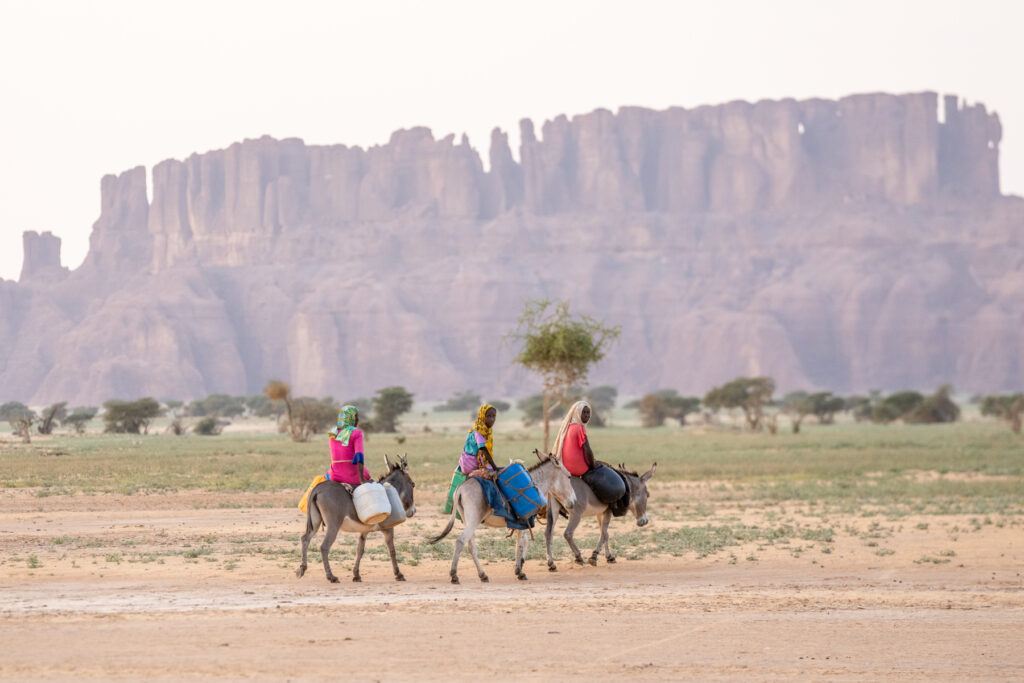
After six years it felt great to finally be back in the Ennedi!
We woke up to a stunning sunrise over the landscapes close to our camp.
Derde camp lay nestled at the base of a gigantic mountain in the Ennedi with a cave at its core in the desert.
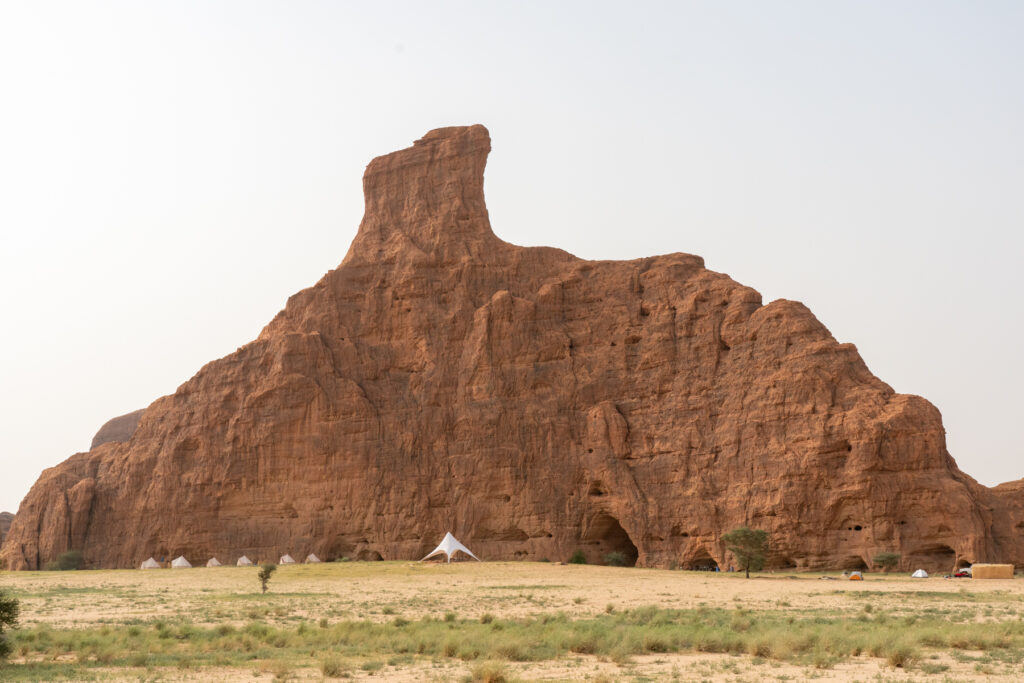
Derde camp in the Ennedi region of northern Chad (image by Inger Vandyke)
We had breakfast and went off exploring some of the magnificent sites of rock art in these wonderful mountains.
Mandaguilé
The first site we reached was only a short drive from where we camped. Mandaguilé featured a main gallery of art plus five small sub-galleries that had accurate and finely detailed depictions of bulls, camel riders, hunters and symbols which might have indicated either grave or well sites.
Mandaguilé had two access points. The first was the main entrance to the site and the second involved a rock scramble up a narrow slot canyon to reach a ledge where we could inspect the art at closer quarters. We also found some ceiling paintings up there.
What a stunning place to whet our appetite for what followed that day!
Archei
After we left Mandaguilé we drove through an ouadi (where one of us got bogged in the sand!) over to the back of the astonishing Saharan oases of Guelta D’Archei where we visited our second rock art site of the same name.
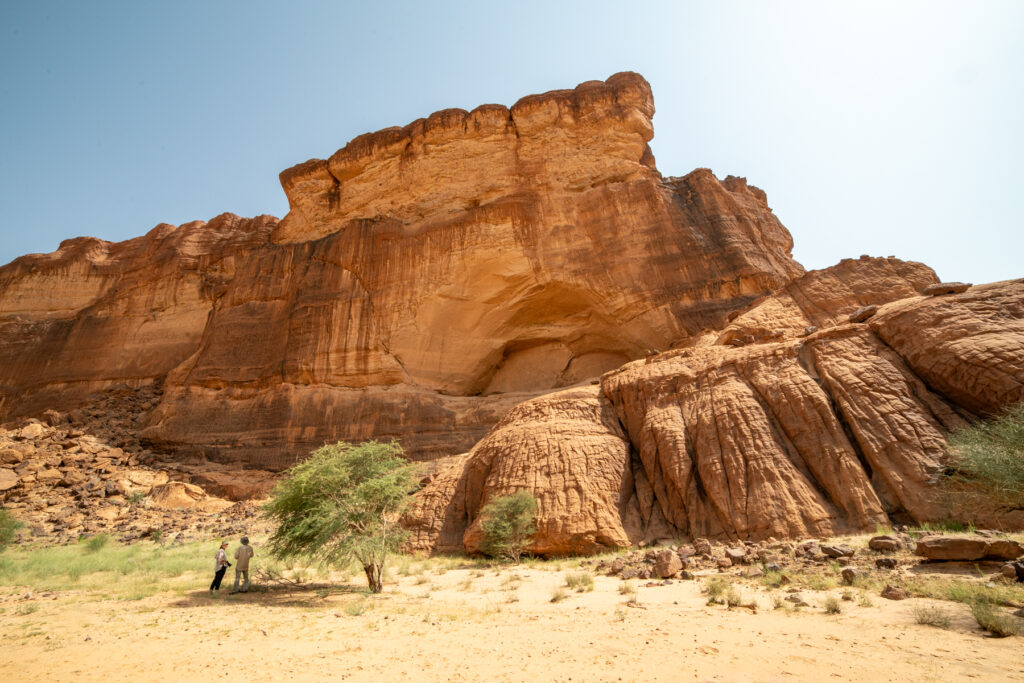
Two of our guests look up to the stunning Ennedi rock art site of Archei (image by Inger Vandyke)
This one involved quite a steep scramble up to a rock ledge but those of us who made it up there were rewarded with an extensive gallery of art that featured bulls, camels, antelopes and some unknown circular features.
Aski
Our third art site was quite fascinating as it seemed to be a regular stopover for Toubou nomads who used the overhanging shelter to store home materials and also corral their animals on occasion. The nomads had also constructed stone granaries to store food and we found an ancient Murumba (camel saddle) lying in the dirt at this site.
Aski featured an upper and lower gallery. The upper had paintings of cows, humans, women with pale heads and hunters. The lower gallery featured images of two giraffes and a buffalo with hunters.
Turkeï
Perhaps one of the most well-known and spectacular art sites in this part of the Ennedi, Turkeï is actually home to two different but closely located galleries, both of which are painted in overhangs of small hillocks that line an impossibly beautiful valley.
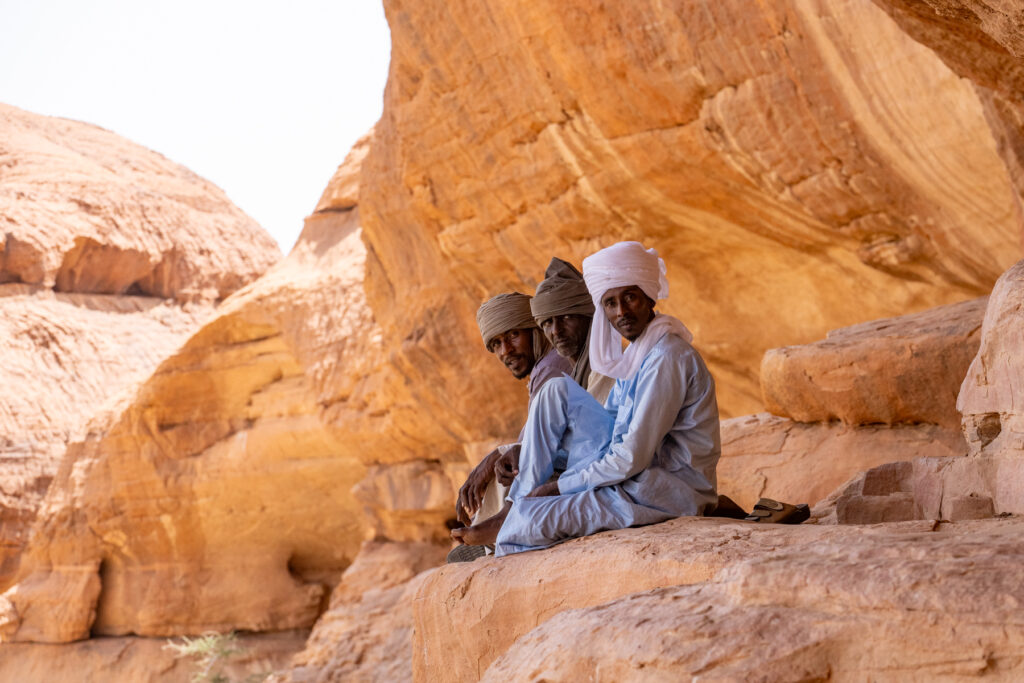
Our Chadian team at the rock art site of Turkeï in the Ennedi (image by Inger Vandyke)
The first site we visited is famous for its gallery of horse riders. These beautiful elongated paintings were up on a rock ledge only a couple of metres from the ground. Next to them were some more paintings of hunters.
La Grande Vache (The Giant Bull)
We walked a short distance from the first site at Turkeï, ascended to a small rock ledge and then we walked through a cave to a valley on the other side of the hillock. This was the site of La Grande Vache, or Giant Bull, which indeed was so large some of us had to lie on our backs and use a wide-angle lens to photograph the painting in its entirety.
We also stopped here to take a ‘keyhole’ landscape photo of the rock arch with the beautiful pastures and neighbouring hills framed by it.
After we left La Grande Vache we drove to Archei town to make a short stop to buy food and then we decided to return to our camp for a late lunch after an eventful morning.
En route we were amused to find a rock platform with numerous caves at its base where herds of donkeys and camels decided to shelter from the midday sun and heat.
After lunch, and as the light got better, we decided to drive off and look at some of the more stunning mountain and natural rock arches of the Ennedi until sunset.
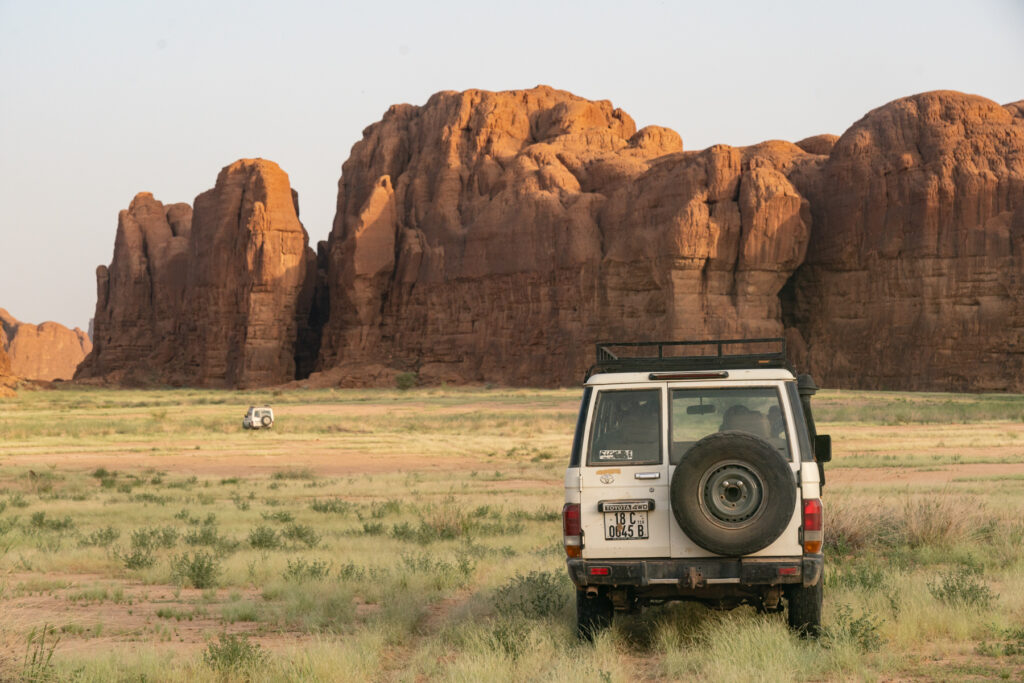
Exploring the Ennedi in the ‘green season’ (image by Inger Vandyke)
Our first stop was actually where the former Derde Camp had been located. The lack of water was the motive behind the move. To be honest both sites were equally spectacular and while we practised doing starbursts in photography of the late sun against the mountains, our team engaged in a spontaneous game of petanque near our cars.
We drove next to a site with twin rock arches which was just beautiful and we stopped to photograph our guide standing at the base of one of them.
Continuing our drive through the rock labyrinth we entered an extremely narrow chasm which was barely wide enough for our cars. Driving through here brought us to a stunning place called Toukoule with its incredibly ornamental skyline of rock pillars silhouetted against the setting sun.
Our last stop of the day was the beautiful Elephant Arch, which looks like the head of an elephant with its trunk hanging down.
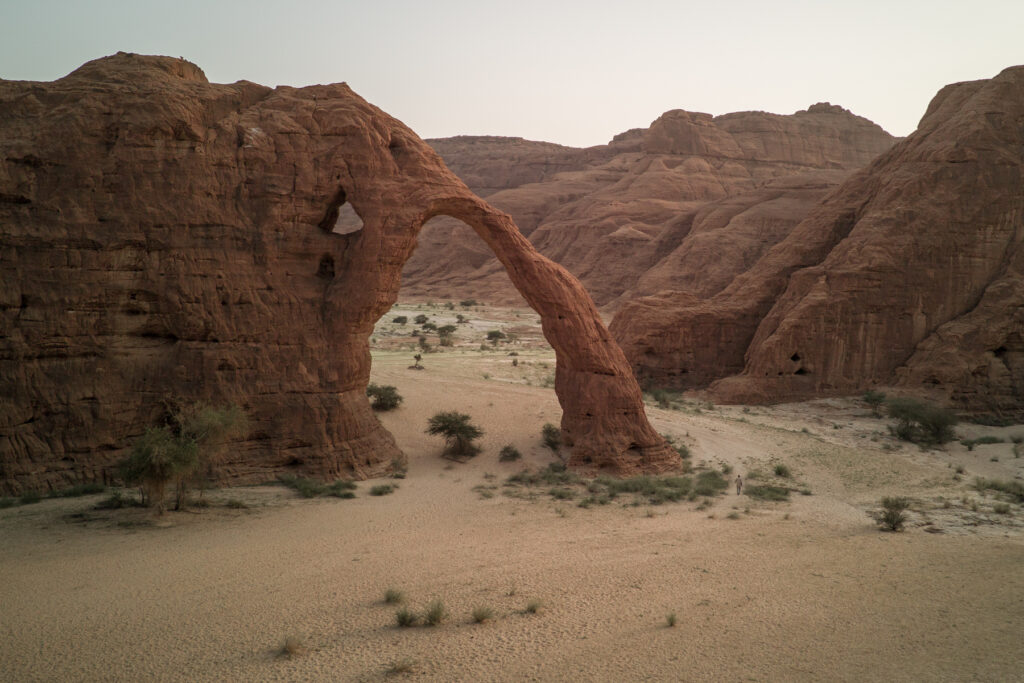
Elephant Arch with our guest walking the track at its base (image by Inger Vandyke)
We returned to our camp and after dinner, I took one of my guests on a ‘sandbox safari’ with a UV light looking for fluorescing scorpions and other desert insects.
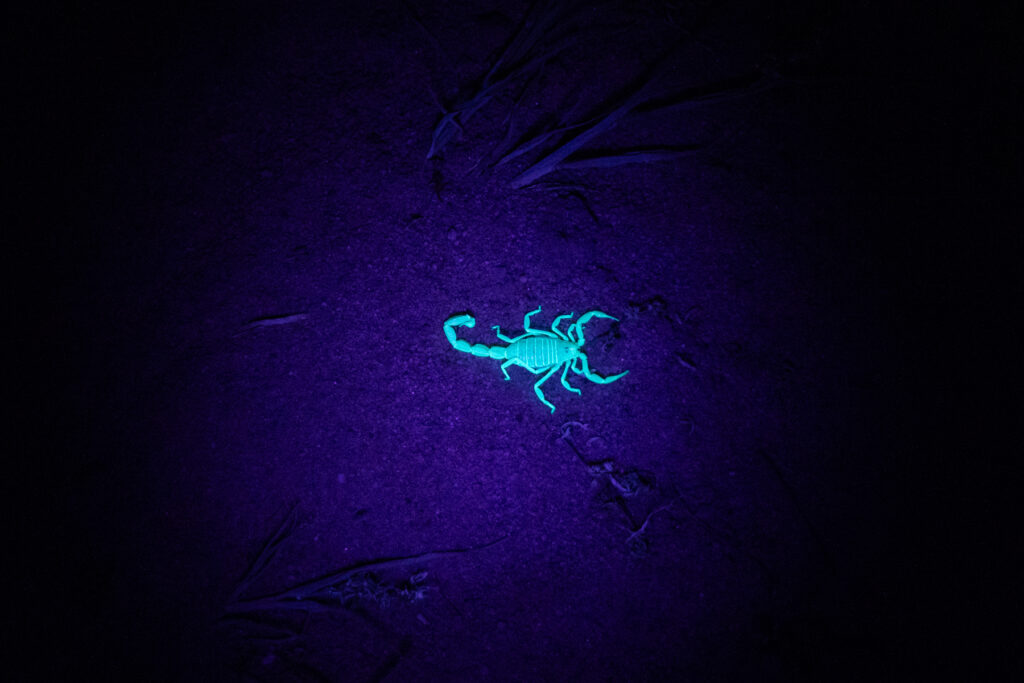
On our ‘sandbox safari’ in the Ennedi we searched for scorpions with a UV light (image by Inger Vandyke)
What an incredible day of Ennedi exploration!
The following morning we woke up to the muted sunrise light of an Araï. One of the characteristic dust storms of Chad had decided to descend on the Ennedi and while we looked at each other, initially crestfallen about the lack of visibility, one of our guests mentioned that we might wish to stay at camp for the day. I replied with an “Absolutely not!” and after breakfast, we embarked on the long drive over to the stunning oasis and rock arch of Bachekele.
Bachekele
It was the start of an extraordinary day that saw us stopping to photograph camels in the mist, nomadic Toubou people and a morning of visiting some Toubou friends of mine at the hamlet of Bachekele before entering the stunning oasis and taking a walk through this incredible place with its spring-fed stream running through the middle.
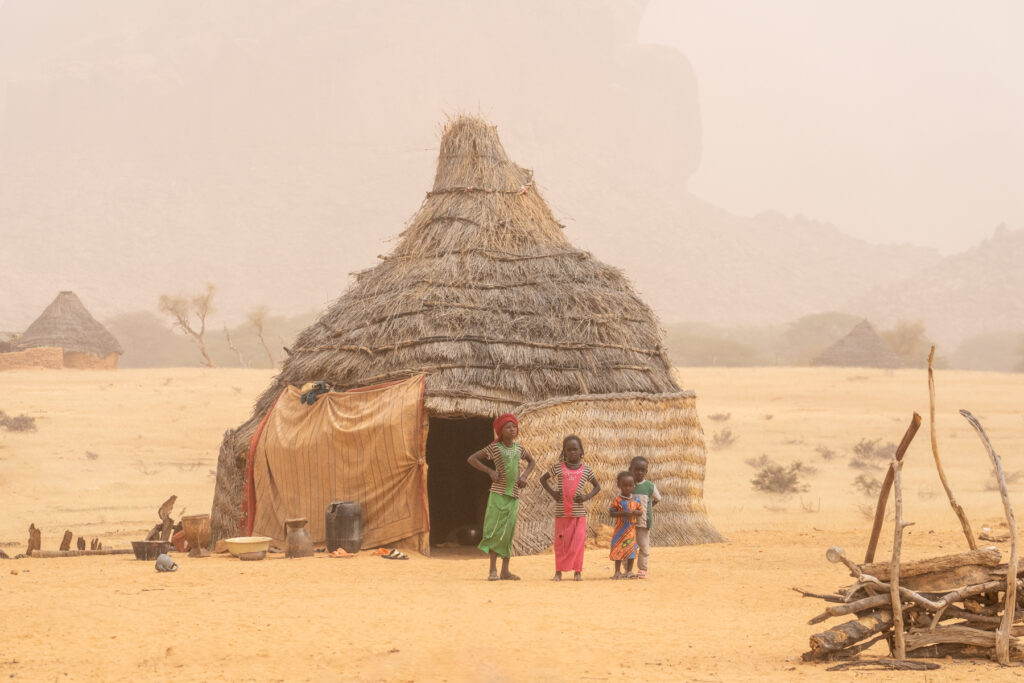
Toubou children standing outside their home in Bachekele, the Ennedi Mountains of Chad (image by Inger Vandyke)
As we walked the oasis we photographed reflections of the mountains in the creek pools, we searched for wildlife visiting the oasis to drink and we met a few Toubou people who had entered the oasis to fetch water, quench the thirst of their camels and donkeys. We met some lovely Toubou children and one young man who kindly allowed us to photograph him washing his camel before loading it up and riding out of the oasis.
Leaving this impossibly pretty place we drove over to the nearby rock arch of Bachekele for lunch under the acacia trees.
Saharan Ostrich Reintroduction Program
Before we went up to the Ennedi one of my guests enquired about the chance of finding Saharan Ostriches in the Ennedi. I wasn’t sure I could promise this. The Ennedi is, after all, similarly sized to Scotland and only 25 of them were released there in the past year.
The largest bird in the world, a small group of Saharan Ostriches were introduced to the Ennedi after being relocated there from Zakouma. It was the first time the Ennedi has seen these birds since they had been killed by hunters and made locally extinct from the Ennedi.
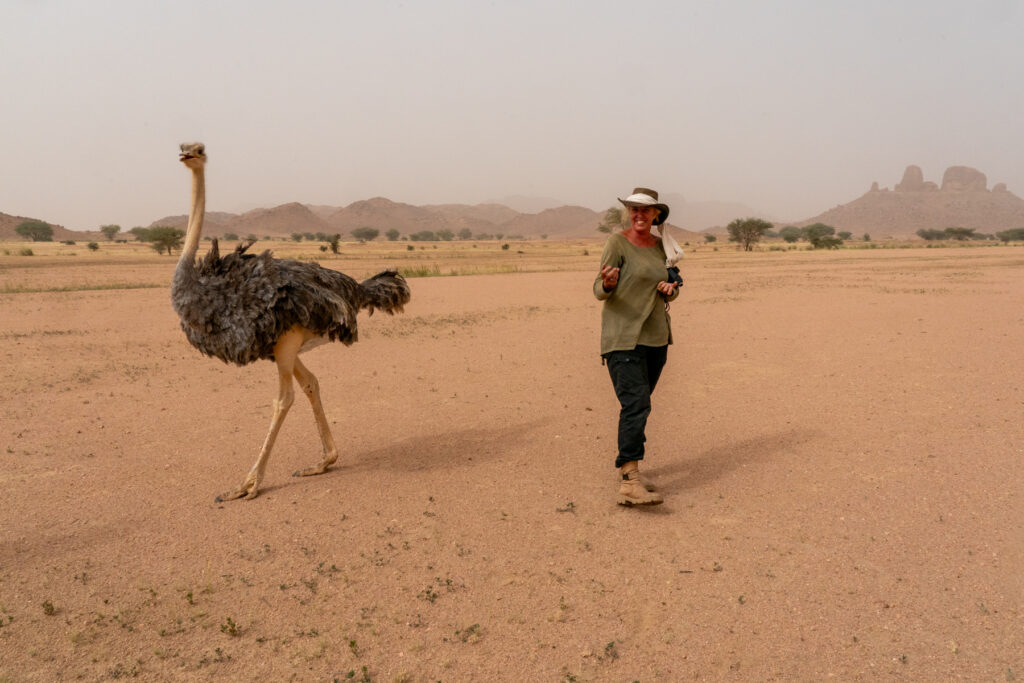
Close encounters with the largest bird on earth in the Ennedi (image by Inger Vandyke)
Well shortly after we left Bachekele one of our guides excitedly yelled out “Ostrich!” and we stopped our cars to meet “23” of the 25 ostriches in all the Ennedi! As a bird that was used to cars, we were all surprised when this gigantic ostrich came straight over to us and even popped its head inside one of the expedition cars to say hello. We got out and he came so close that some of us could only photograph him using a short lens. What an amazing surprise! Meeting him was a highlight of our stay in the Ennedi!
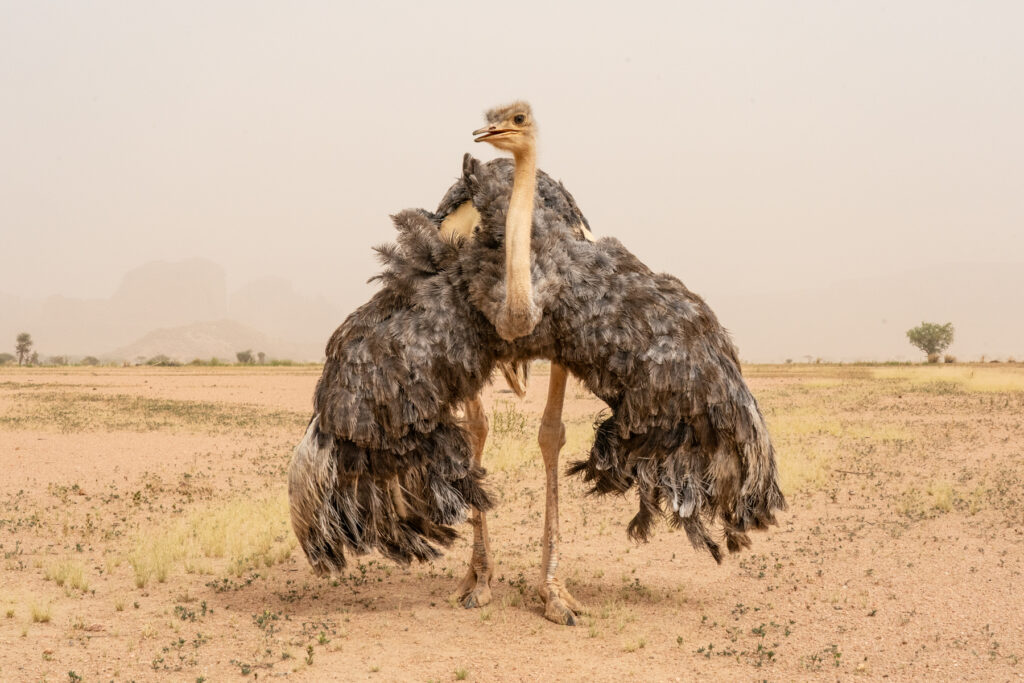
“Number 23” Saharan Ostrich. As one of only 25 birds on the Ennedi reintroduction program we were lucky to meet him (image by Inger Vandyke)
We reluctantly moved on from him after taking numerous photos and we drove over to the largest rock arch in the world, Aloba, stopping to photograph pretty Toubou homes and stunning scenery.
Aloba Arch
Our first glimpse of the astonishing Aloba Arch quite literally took our breaths away. This extraordinary place is the highest natural rock arch on earth at 120m. It’s height was only digitally recorded in 2007 and it is larger than any rock arch in either the United States or China.
We spent some time here wandering through this otherworldly landscape of soaring cliffs, silent valleys and lonely acacia trees. It’s difficult to really gauge the size of this place in photos but I flew a drone up over it to finally capture it all. Even then I had to fly a significant distance back to capture the arch in its entirety.
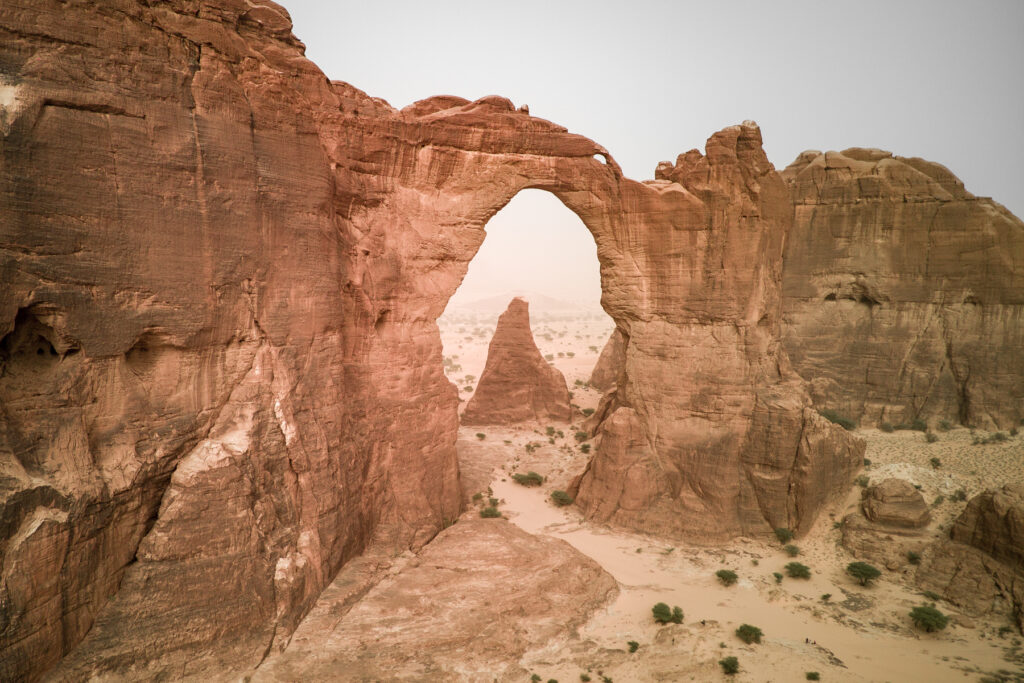
Drone’s eye view of the arch of Aloba, the tallest rock arch in the world. At the base through the arch is our expedition vehicles (image by Inger Vandyke)
As we walked out we stopped to chat with some local Toubou women and children who had dropped by to visit our expedition vehicles.
We then drove on towards a large table shaped rock outcrop with a cave at its base. We stopped to photograph the expedition cars driving through it and continued on to our camp. Sadly we got a flat tyre which delayed our return so we arrived in the evening to enjoy a later dinner.
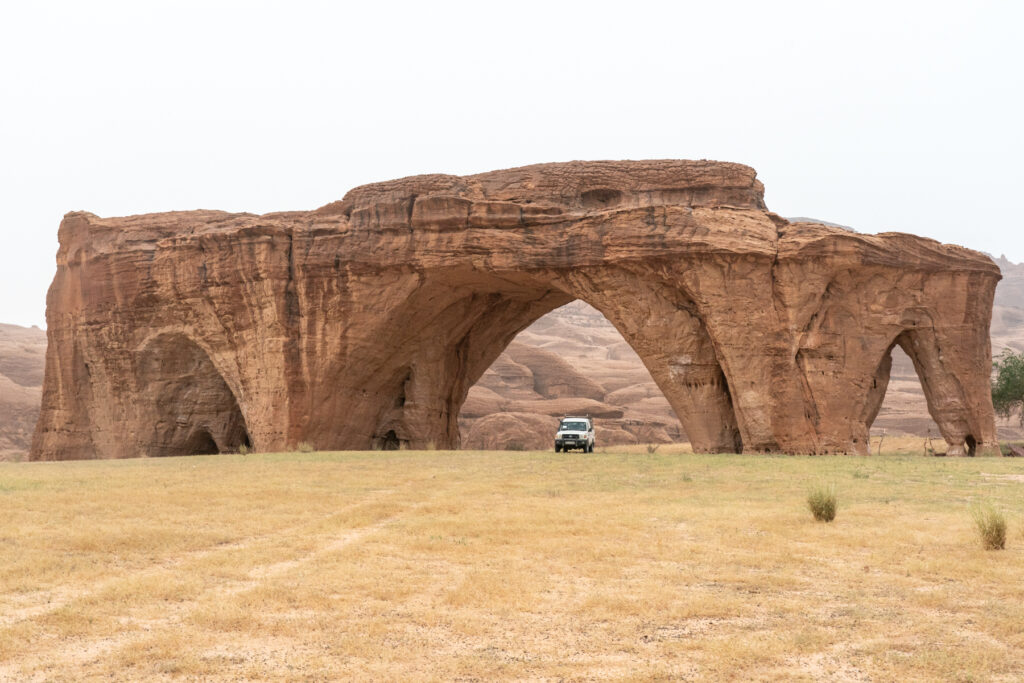
Driving through one of the arches of the Ennedi (image by Inger Vandyke)
Guelta D’Archei
Our final morning in the Ennedi saw us leaving camp early to start the walk into the famous Guelta D’Archei, possibly the most beautiful desert oasis in the world. Sadly the recent rains in the Ennedi had left so much water around the mountains that there was no pressing need for the local Toubou people to bring their camels to drink at the Guelta.
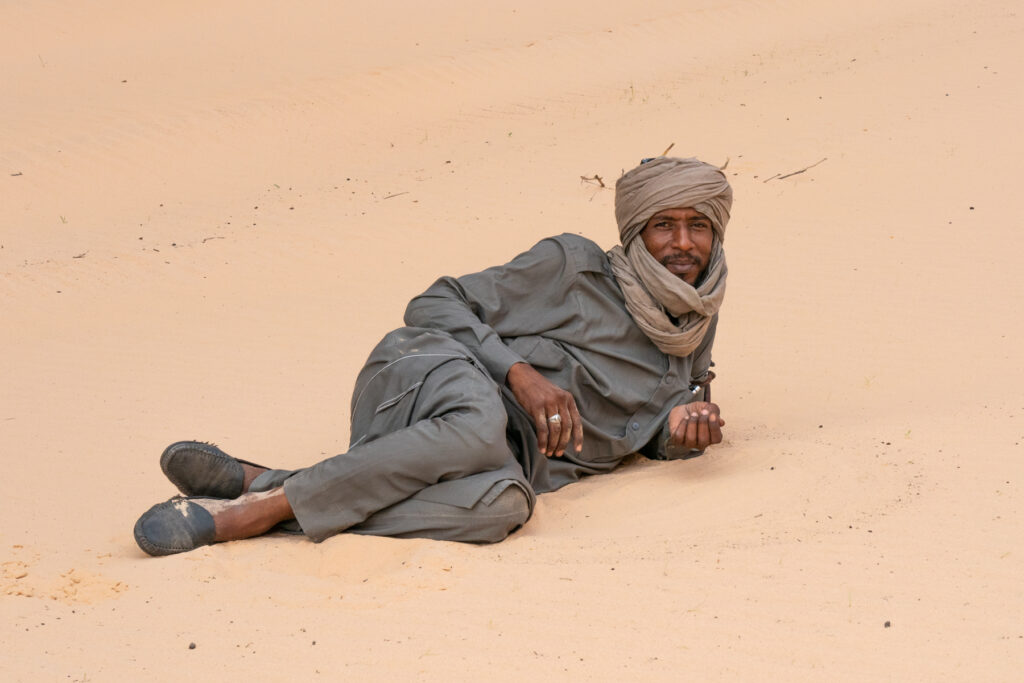
Our wonderful English translator and guide, Yves (image by Inger Vandyke)
The walk and the landscapes were nonetheless as impressive as they always have been. It’s a bit of an energetic hike to reach what I have always jokingly called “The Hyrax Hole”, essentially a rock ledge where you can combat roll on your belly to get out onto it and look out over the oasis. The effort is almost always worth it with stunning scenery and if you were lucky, a glimpse of the last extant population of Saharan Crocodiles living in the oasis.
Sadly we dipped on the crocodiles too but we did spend quite a bit of time exploring the cliffs and enjoying encounters with the oasis’ resident Rock Hyraxes as we walked.
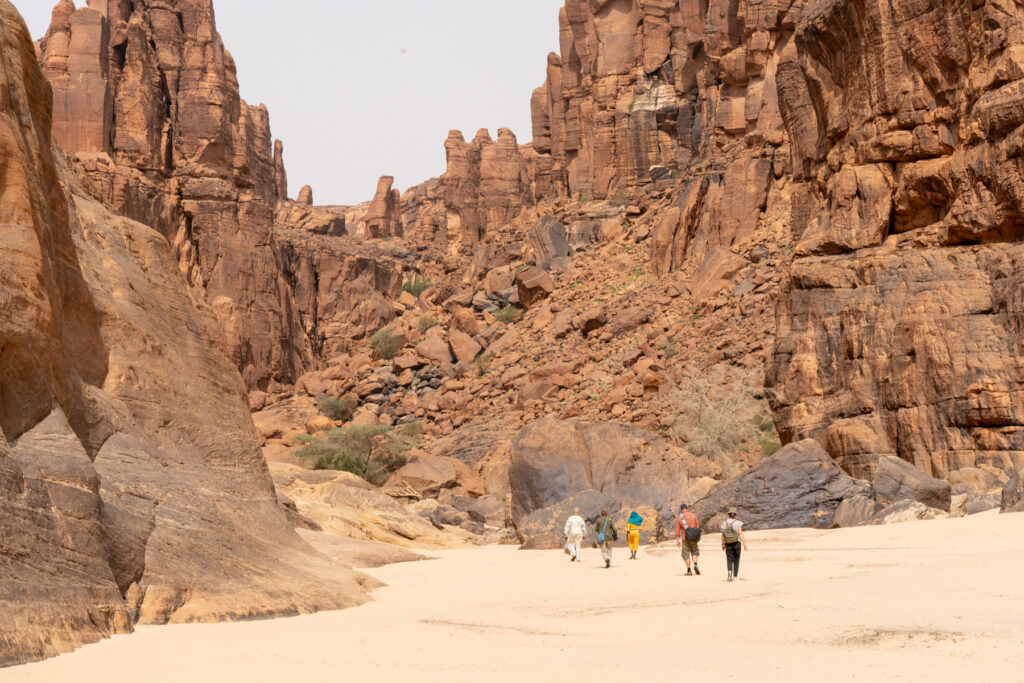
Our group hiking into Guelta D’Archei (image by Inger Vandyke)
We returned to our cars by the time the heat was really setting in and our first priority was to grab a drink of water. A small group of Toubou girls had also met our cars and they were selling some local souvenirs so we bought some from them before we left.
We decided to drive around to the sandy river base of the Guelta to take a walk in it before we returned to camp. Even with the Araï effects still lingering from the previous day it was still an extraordinarily beautiful thing to see.
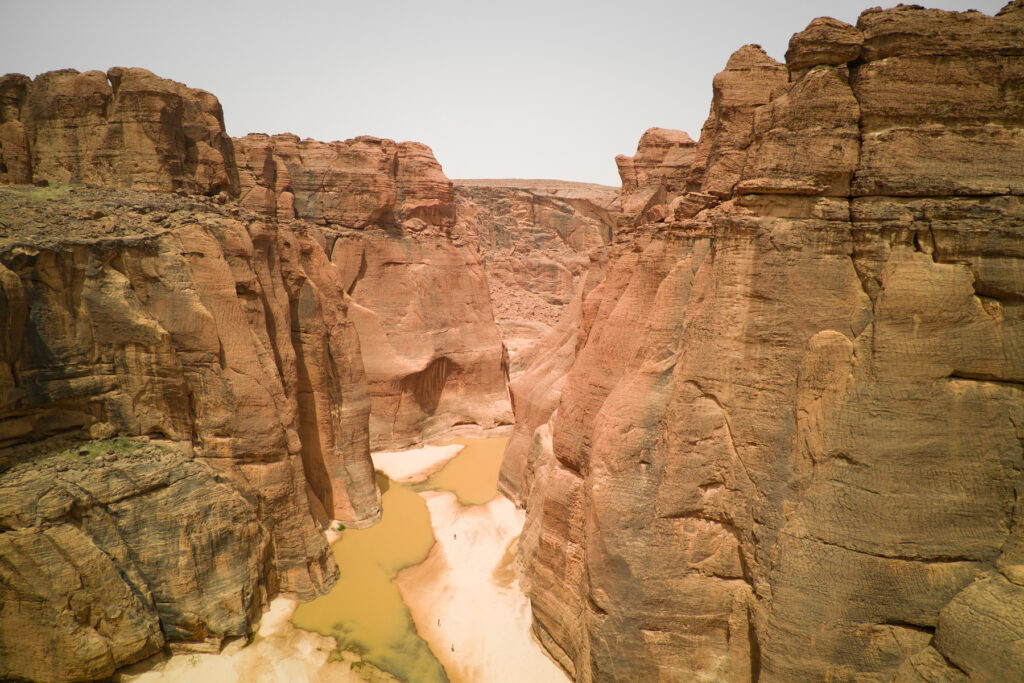
Our guests walk into the base of the Guelta D’Archei oasis in the Ennedi (image by Inger Vandyke)
Returning to camp for lunch we packed up our cars and started our drive south back towards N’Djamena.
We chose a different route to our drive north so we could make a small detour and visit one of the rusting tanks from the Libyan Chadian war. This one was so remote that we could stop and take photos. So we enjoyed a pit stop for that and took some group photos of our Chadian team sitting on top of it before we drove further to Kalait.
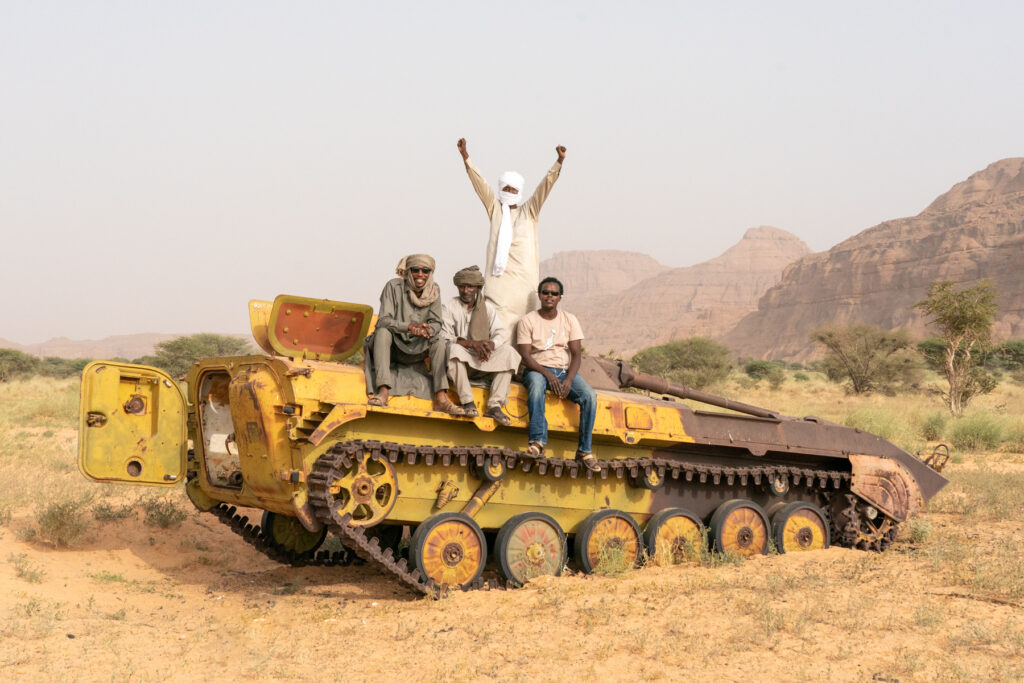
Our Chadian expedition team on the rusting remains of a Libyan tank in the Ennedi (image by Inger Vandyke)
Late that afternoon we found a pretty place in the desert around 20 kilometres north of Kalait to enjoy our last overnight of this Saharan section of the trip.
The next morning we took some group shots before we embarked on an extraordinarily long two days of driving to get back to N’Djamena via Abeche.
Sadly about 10 minutes out of Kalait one of our cars ran out of fuel so we quickly arranged for a motorcycle to bring a cannister out to us so we could continue our journey south.
As always in Kalait we had to stop and refuel and make sure our vehicles were OK to continue our drive south, so we had another small chance to wander around the town taking photos before we left to make our way out of the desert.
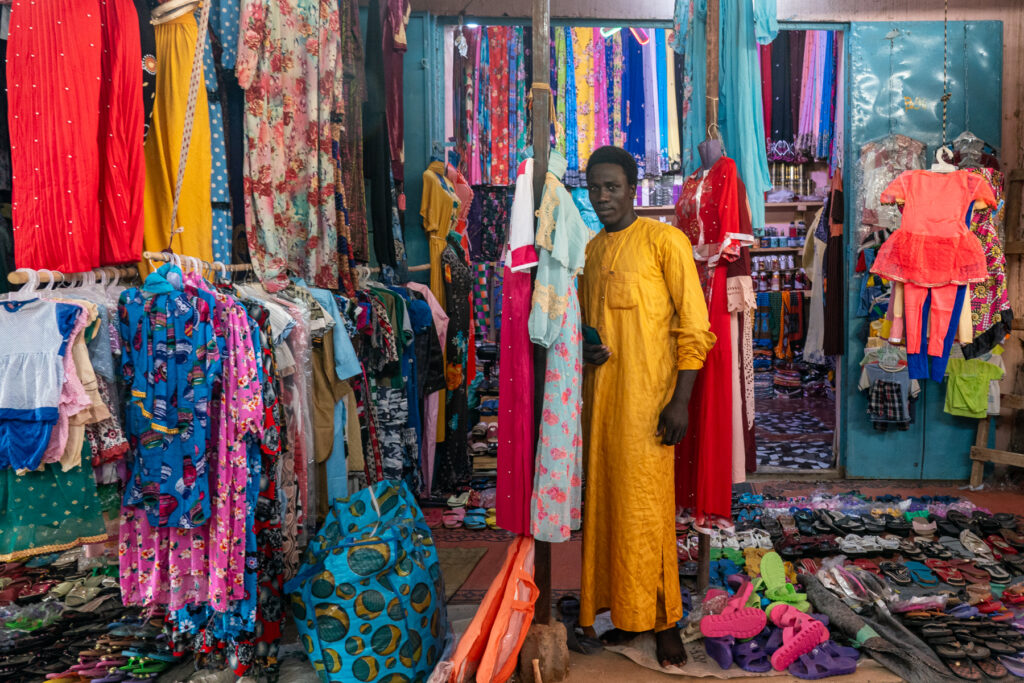
Street photography in Kalait, Chad (image by Inger Vandyke)
The drive to Abeche was fairly uneventful as we tried to reach Abeche before it got dark. The main towns we stopped at were Arada and Biltine.
The landscape slowly morphed from desert savannahs to acacia woodlands as we made our way south – a stark reminder of the different climatic zones of this vast country.
We didn’t make it before sunset and shortly before we reached the town we had a longer than expected stop at a security checkpoint while soldiers went through all of our paperwork to verify that we were tourists.
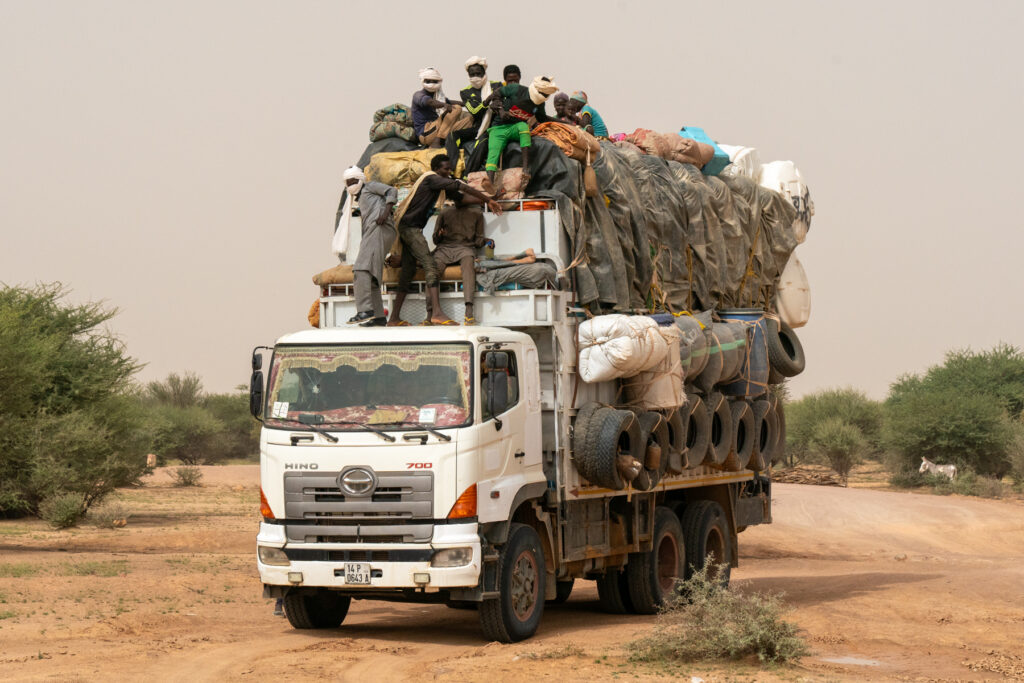
A typical trans-African truck in northern Chad (image by Inger Vandyke)
Abeche
Abeche has always been a bustling commercial centre. These days, in light of the conflict in neighbouring Sudan, it has also become a large centre for a refugee camp that is home to several thousand Sudanese refugees fleeing conflict. Although we didn’t see the refugee camp, or even any evidence of it, the heightened security around Abeche was an obvious sign that it was there.
We pulled into our basic guest house and after some last minute worries about water supply decided to stay, have a late dinner and grab what sleep we could in the simple rooms.
The next morning we woke up and met the guest house owners who had actually spent some time living in Switzerland.
They had a small selection of Chadian traditional art and jewellery for sale so we all did a little bit of shopping before we jumped on the road to drive to N’Djamena.
Oddly we enjoyed a fairly good stretch of road between Abeche and Mongo.
Light rains began to fall and we all started to notice nomadic groups of Arabe people on the move with their ‘camel boxes’, one of the traditional modes of carrying goods on camel backs and we were tinged with a little sadness that we couldn’t stop to meet them due to time constraints.
Mongo
We arrived in Mongo around lunchtime and took the chance to fuel the cars, fix tyres and take a break before continuing our trip.
From our lunch stop in Mongo, we had a clear view of the “Queen of Guera” one of the iconic mountains of Abtouyour as it looks like a pregnant lady lying on her back.
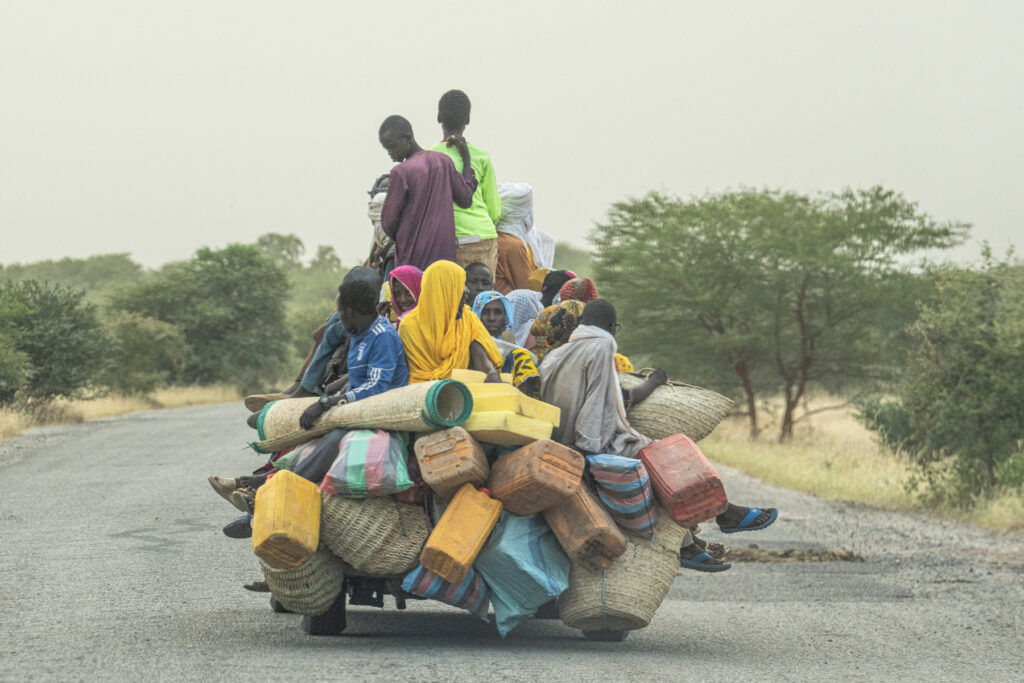
African people don’t travel, they move. On the road in remote Chad (image by Inger Vandyke)
The road between Mongo and N’Djamena was in way worse condition than all of us had originally planned for. The countless potholes making it a tiring day for all of us.
Abtouyour Mountains
Our only consolation was the stunning scenery of the Abtouyour Mountains, a series of jagged granitic peaks that is home to the fourth-highest mountain in Chad.
We drove through this mountain wonderland spotting our first group of Patas Monkeys bolting across the road, an unusually large flock of African Grey Hornbills and also huge flocks of Abdim’s Storks feeding in waterholes created by the recent rains. It felt like a mountain sanctuary dotted with the tiny villages of local Hadjaraye people with their pretty huts topped with conical straw rooves.
It was getting late by the time we reached the outskirts of the city. Due to the fact all of the local restaurants would be closed for dinner, I arranged for one of them to make us some hot takeaway food so we could at least eat when we arrived.
By the time we got back to the city, we were all exhausted and in need of a shower and rest. We said farewell to our expedition team in the lobby of the hotel and went to bed.
Chad travel has never been for the faint-hearted or the timid. Accessing parts of the world that so few people get to see often requires more than just a sense of adventure. You also need a gritty level of determination, a will to put up with endless grass seeds (kram kram) in the rainy season, a heightened ability to change car tyres with speed, truckloads of patience and above everything a good sense of humour.
Thankfully these characteristics defined my incredible group. Even with the inevitable hardships if someone asked me if I’d go again, my first reaction would be an enthusiastic “YES!”. Especially with my group of intrepid photography guests.
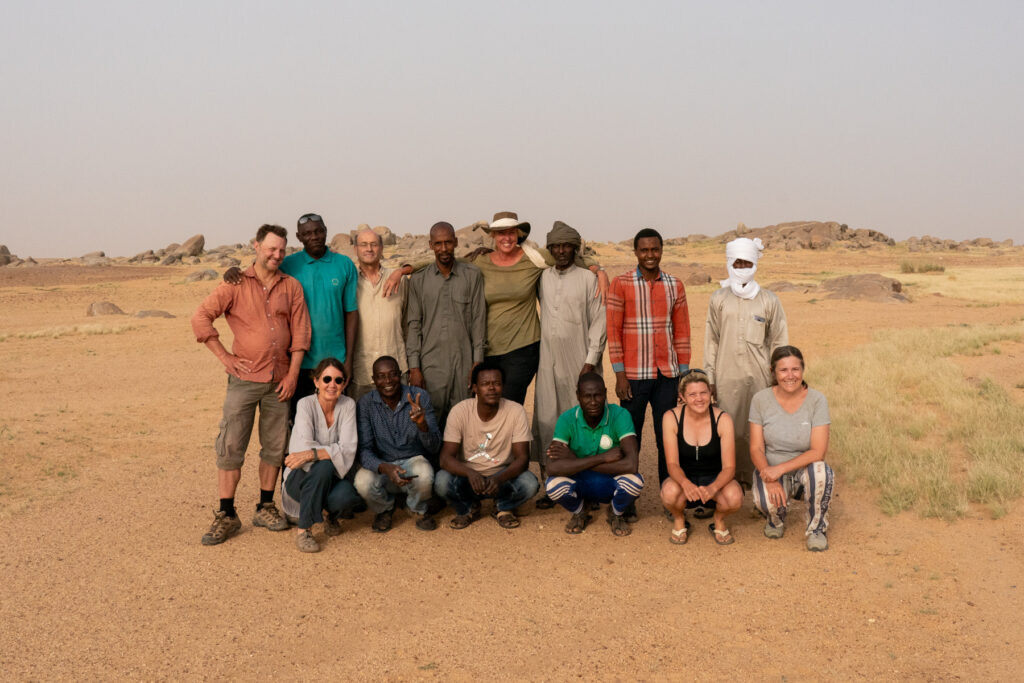
Our intrepid expedition group in northern Chad. What a magnificent bunch of people! (image by Inger Vandyke)



























































































